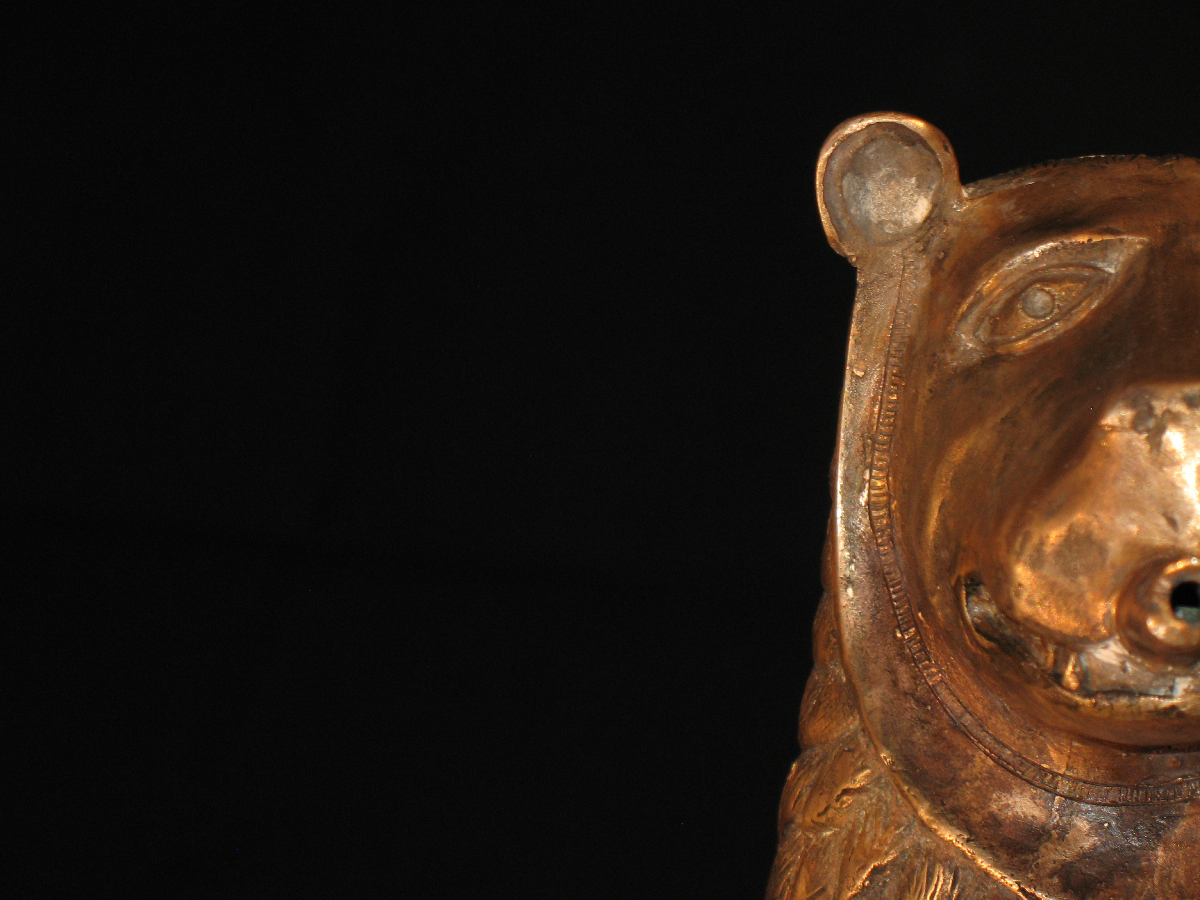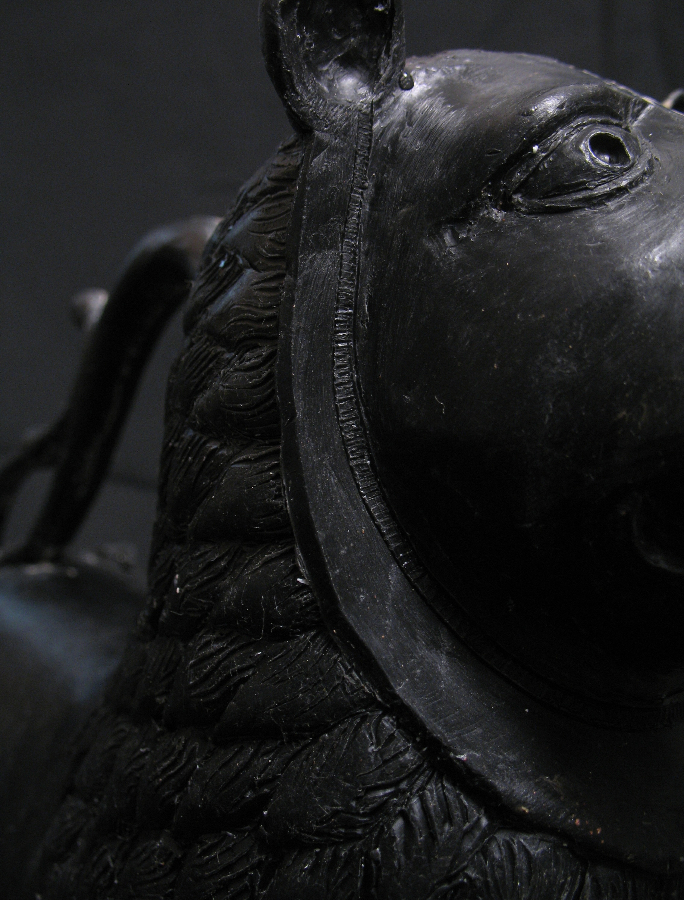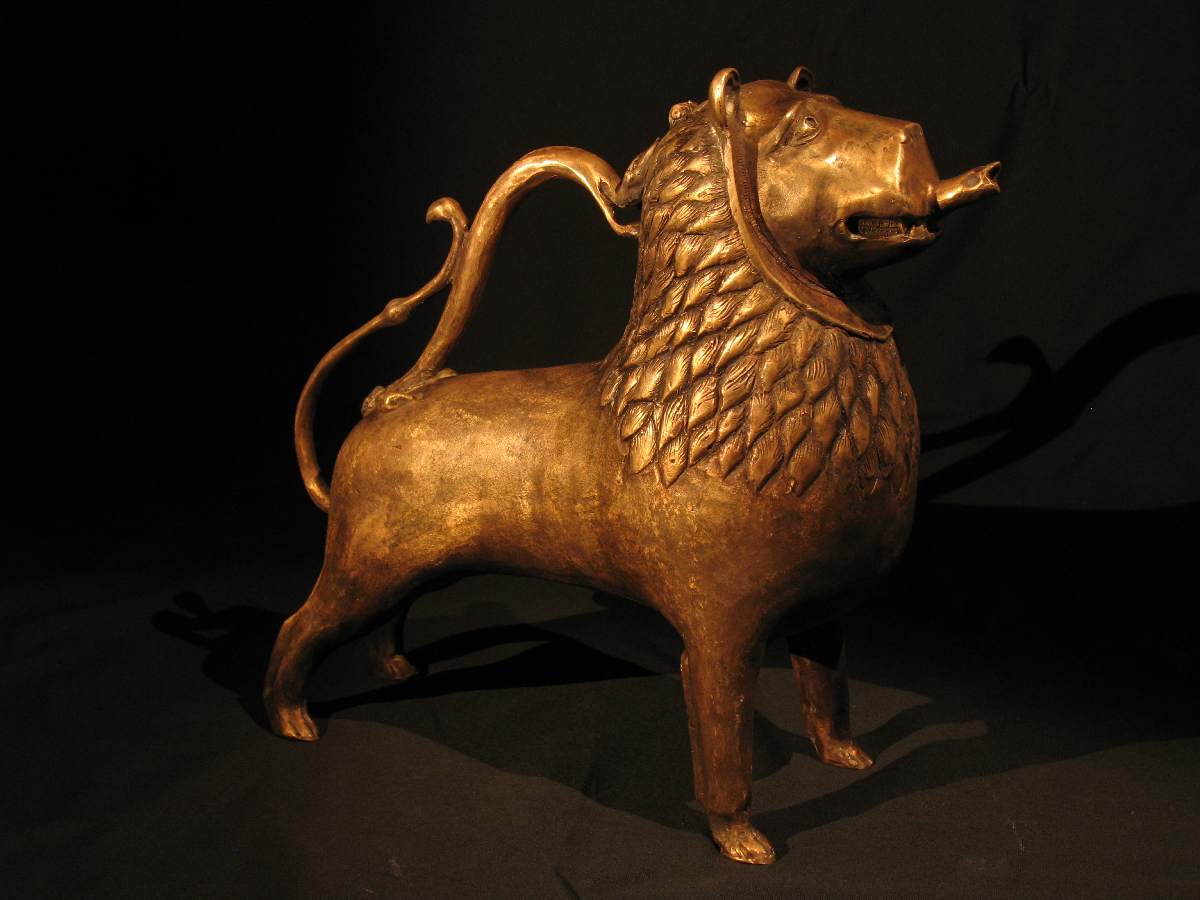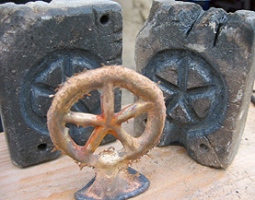
A very brief introduction to casting processes
The production and casting of metals is a very old trade and is known at least for the last 7000 years or so. Early evidence for mining can be found at Ai Bunar, Bulgaria and Rudna Glava, Serbia from 5000 BC onwards. Casting is a very efficient and cheap way to manufacture a desired good. This is especially true for metals. Casting processes can be discerned by the way a mould is produced. There are two possibilities: permanent moulds and lost moulds.
Lost moulds can be used only once. In order to retrieve the raw cast you have to destroy them. Permanent moulds can be used for multiple casts; they are usually made of two, three or more parts, to allow for the retrieval of the cast. Lost moulds require a pattern permanent moulds do not.
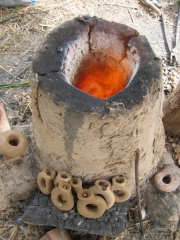
Moulding process should further be classified by the way the model or pattern is handled. There are lost models and permanent patterns. Generally patterns is the term for models used for sand-casting, whereas with the lost-wax method it is often called a model. But as far as I can see, the English/American terminology is unfortunately rather ambiguous. This page is concerned primarily concerned with heritage casting processes, which is why modern processes are not discussed here, however I make use of modern terminology wherever feasible.
Lost moulds and lost models These are the most important lost mould processes with lost models:
- lost wax process
- traditional bell founding
- traditional gun founding
In the literature lost moulds are often said to be moulds of the lost wax or cire perdu process. This is incorrect as sand moulds are also lost moulds, as are the others mentioned above. In brief, the lost wax process uses positive wax model which is being invested in a moulding material, then heated, upon which the melting wax produces the mould cavity. This requires an individual model per cast. Early bells were made like this. The English/American terminology in the humanities coined the term direct and indirect lost wax process. This addresses the means of making the wax model, i.e. if each wax model made individually from scratch, or if the wax model in itself was replicated by more efficient means, e.g. from a mould.
Some time after the 12th century the use of the lost wax method for bell founding was replaced by a more wax-saving process, which we nowadays call traditional bell founding process. This uses a strickle board to make the bell model from fine clay, which is used to make the two-part mould. Before casting the false dell (clay bell model) is removed. A similar technology came to bear in the production of cannon and, again, slightly modified also for the production of vessels such as cauldrons.
Lost moulds and permanent patterns
The single most important method mentioned her should be casting in sand moulds, which re-uses its permanent patterns. Sand moulds on the contrary possess permanent patterns which are being reused every time a sand-mould is made. Casting in sand moulds cannot be traces back very far. The earliest mentioning of this technique in our hemisphere is probably Al Jazari aorund AD 1200 . Susan La Niece published an excellent article putting forward the scarce evidence we have for early sand casting . In central Europe the earliest evidence is tzo found in written sources of the 16th century . Suggestions put forward by Egg that Gregor Löffler had introduced sand casting to gun founding are without any substance and reveal a simplistic view of foundry processes by that author.
Moulding loam – an ingenious material
In general, a moulding material should meet the following requirements:
- refractory
- no shrinkage
- gas-permeable
- fine-grained
- slight decay after casting (not relevant for older processes)
Since pure clay is too fat, i.e. it shows too much shrinkage in pure form, the clay must be made leaner. This is done with inorganic and organic materials, which is called temper or grog. Archaeologically proven and/or historically/ethnographically documented temper is e.g.: (quartz) Sand, crushed old forms, animal hair, horse manure and chaff. The clay acts as a binder for the inorganic, refractory ageing agents. Since these do not shrink during drying, the shrinkage of the moulding material can be adjusted via their proportion.
Organic tempers have a different function; they improve the plastic properties in the green state. Due to their fibrous shape, they reduce cracking during drying. They improve the gas permeability as they burn when firing the moulds. The moulding loam is/was produced by each foundryman himself/herself and can be produced with experience at any place where work is/was done. The raw materials are available everywhere.
Historical sources such as Theophilus Presbyter in the 12th century , Vanoccio Biringuccio or Cellini in the 16th century share their recipes with us. Also at Lazarus Ercker, the famous sampler and metallurgist of the 16th century, you can find some hints on how to use clay to produce refractory materials .
Dies, permanent moulds
You do not need a model, but you have to engrave a three-dimensional negative into the moulding material. You also want to be careful as to ensure that the cast can be retrieved from the mould halves. This seriously restricts the design of your object and at least for prehistoric times this moulding technique yielded far less complicated cast products than the lost wax process. They are also more labour intensive to manufacture. The advantage is the re-usability of these, and many objects can be cast without much effort once a mould is made. The materials for permanent moulds have to be refractory and hard-wearing, e.g. stone and metal.
References
{1698736:AM67XJ8T};{1698736:YSQDXETP};{1698736:NEPW8PGR},{1698736:AKNCU5DE};{1698736:572VHZZ3};{1698736:RJWDMP9E},{1698736:WKXBJD4Q};{1698736:NEPW8PGR};{1698736:AKNCU5DE};{1698736:D3R8K76K}
apa
default
0
1618
%7B%22status%22%3A%22success%22%2C%22updateneeded%22%3Afalse%2C%22instance%22%3Afalse%2C%22meta%22%3A%7B%22request_last%22%3A1200%2C%22request_next%22%3A50%2C%22used_cache%22%3Atrue%7D%2C%22data%22%3A%5B%7B%22key%22%3A%2226JM8AN2%22%2C%22library%22%3A%7B%22id%22%3A1698736%7D%2C%22meta%22%3A%7B%22creatorSummary%22%3A%22Stephan%20M%5Cu00f6slein%22%2C%22parsedDate%22%3A%222008%22%2C%22numChildren%22%3A1%7D%2C%22bib%22%3A%22%26lt%3Bdiv%20class%3D%26quot%3Bcsl-bib-body%26quot%3B%20style%3D%26quot%3Bline-height%3A%202%3B%20padding-left%3A%202em%3B%20text-indent%3A-2em%3B%26quot%3B%26gt%3B%5Cn%20%20%26lt%3Bdiv%20class%3D%26quot%3Bcsl-entry%26quot%3B%26gt%3BStephan%20M%26%23xF6%3Bslein.%20%282008%29.%20Fr%26%23xFC%3Bhbronzezeitliche%20Depotfunde%20im%20Alpenvorland%20%26%23x2013%3B%20neue%20Befunde%20%28pp.%20109%26%23x2013%3B130%29.%20Presented%20at%20the%20Vortr%26%23xE4%3Bge%20des%2026.%20NIederbayerischen%20Arch%26%23xE4%3Bologentages%2C%20Deggendorf%2C%20Rahden%5C%2FWestfalen.%26lt%3B%5C%2Fdiv%26gt%3B%5Cn%26lt%3B%5C%2Fdiv%26gt%3B%22%2C%22data%22%3A%7B%22itemType%22%3A%22conferencePaper%22%2C%22title%22%3A%22Fr%5Cu00fchbronzezeitliche%20Depotfunde%20im%20Alpenvorland%20%5Cu2013%20neue%20Befunde%22%2C%22creators%22%3A%5B%7B%22creatorType%22%3A%22author%22%2C%22name%22%3A%22Stephan%20M%5Cu00f6slein%22%7D%5D%2C%22abstractNote%22%3A%22%22%2C%22date%22%3A%222008%22%2C%22proceedingsTitle%22%3A%22%22%2C%22conferenceName%22%3A%22Vortr%5Cu00e4ge%20des%2026.%20NIederbayerischen%20Arch%5Cu00e4ologentages%2C%20Deggendorf%22%2C%22language%22%3A%22%22%2C%22DOI%22%3A%22%22%2C%22ISBN%22%3A%22%22%2C%22url%22%3A%22%22%2C%22collections%22%3A%5B%5D%2C%22dateModified%22%3A%222019-05-31T15%3A13%3A30Z%22%7D%7D%2C%7B%22key%22%3A%2246XIMTVI%22%2C%22library%22%3A%7B%22id%22%3A1698736%7D%2C%22meta%22%3A%7B%22creatorSummary%22%3A%22J.J.%20Butler%22%2C%22parsedDate%22%3A%222002%22%2C%22numChildren%22%3A1%7D%2C%22bib%22%3A%22%26lt%3Bdiv%20class%3D%26quot%3Bcsl-bib-body%26quot%3B%20style%3D%26quot%3Bline-height%3A%202%3B%20padding-left%3A%202em%3B%20text-indent%3A-2em%3B%26quot%3B%26gt%3B%5Cn%20%20%26lt%3Bdiv%20class%3D%26quot%3Bcsl-entry%26quot%3B%26gt%3BJ.J.%20Butler.%20%282002%29.%20Ingots%20and%20Insights%3A%20Reflections%20on%20Rings%20and%20Ribs.%20In%20%26lt%3Bi%26gt%3BDie%20Anf%26%23xE4%3Bnge%20der%20Metallurgie%20in%20der%20alten%20Welt%20%3D%3A%20The%20beginnings%20of%20metallurgy%20in%20the%20old%20world%26lt%3B%5C%2Fi%26gt%3B%20%28pp.%20229%26%23x2013%3B243%29.%20Rahden%2C%20Westf%3A%20Verlag%20Marie%20Leidorf.%26lt%3B%5C%2Fdiv%26gt%3B%5Cn%26lt%3B%5C%2Fdiv%26gt%3B%22%2C%22data%22%3A%7B%22itemType%22%3A%22bookSection%22%2C%22title%22%3A%22Ingots%20and%20Insights%3A%20Reflections%20on%20Rings%20and%20Ribs%22%2C%22creators%22%3A%5B%7B%22creatorType%22%3A%22author%22%2C%22name%22%3A%22J.J.%20Butler%22%7D%5D%2C%22abstractNote%22%3A%22%22%2C%22bookTitle%22%3A%22Die%20Anf%5Cu00e4nge%20der%20Metallurgie%20in%20der%20alten%20Welt%20%3D%3A%20The%20beginnings%20of%20metallurgy%20in%20the%20old%20world%22%2C%22date%22%3A%222002%22%2C%22language%22%3A%22ger%20eng%20fre%22%2C%22ISBN%22%3A%22978-3-89646-871-0%22%2C%22url%22%3A%22%22%2C%22collections%22%3A%5B%5D%2C%22dateModified%22%3A%222019-05-31T15%3A09%3A14Z%22%7D%7D%2C%7B%22key%22%3A%22AWUKGXXR%22%2C%22library%22%3A%7B%22id%22%3A1698736%7D%2C%22meta%22%3A%7B%22numChildren%22%3A0%7D%2C%22bib%22%3A%22%26lt%3Bdiv%20class%3D%26quot%3Bcsl-bib-body%26quot%3B%20style%3D%26quot%3Bline-height%3A%202%3B%20padding-left%3A%202em%3B%20text-indent%3A-2em%3B%26quot%3B%26gt%3B%5Cn%20%20%26lt%3Bdiv%20class%3D%26quot%3Bcsl-entry%26quot%3B%26gt%3BIngots%20and%20Insights%3A%20Reflections%20on%20RIngs%20and%20Ribs.%20%28n.d.%29%20%28pp.%20229%26%23x2013%3B243%29.%26lt%3B%5C%2Fdiv%26gt%3B%5Cn%26lt%3B%5C%2Fdiv%26gt%3B%22%2C%22data%22%3A%7B%22itemType%22%3A%22conferencePaper%22%2C%22title%22%3A%22Ingots%20and%20Insights%3A%20Reflections%20on%20RIngs%20and%20Ribs%22%2C%22creators%22%3A%5B%5D%2C%22abstractNote%22%3A%22%22%2C%22date%22%3A%22%22%2C%22proceedingsTitle%22%3A%22%22%2C%22conferenceName%22%3A%22%22%2C%22language%22%3A%22%22%2C%22DOI%22%3A%22%22%2C%22ISBN%22%3A%22%22%2C%22url%22%3A%22%22%2C%22collections%22%3A%5B%5D%2C%22dateModified%22%3A%222019-05-31T15%3A06%3A07Z%22%7D%7D%2C%7B%22key%22%3A%225H87R8UU%22%2C%22library%22%3A%7B%22id%22%3A1698736%7D%2C%22meta%22%3A%7B%22creatorSummary%22%3A%22Dines%22%2C%22parsedDate%22%3A%222010%22%2C%22numChildren%22%3A1%7D%2C%22bib%22%3A%22%26lt%3Bdiv%20class%3D%26quot%3Bcsl-bib-body%26quot%3B%20style%3D%26quot%3Bline-height%3A%202%3B%20padding-left%3A%202em%3B%20text-indent%3A-2em%3B%26quot%3B%26gt%3B%5Cn%20%20%26lt%3Bdiv%20class%3D%26quot%3Bcsl-entry%26quot%3B%26gt%3BDines%2C%20I.%20%282010%29.%20The%20Theophilus%20Manuscript%20Tradition%20Reconsidered%20in%20the%20Light%20of%20New%20Manuscript%20Discoveries.%20In%20M.%20Maui%26%23xE8%3Bge%20%26amp%3B%20H.%20Westerman-Angerhausen%20%28Eds.%29%2C%20%26lt%3Bi%26gt%3BZwischen%20Kunsthandwerk%20und%20Kunst%3A%20Die%20Schedula%20diversarum%20artium%26lt%3B%5C%2Fi%26gt%3B%20%28pp.%203%26%23x2013%3B14%29.%20Berlin%5C%2FBoston%3A%20de%20Gruyter.%26lt%3B%5C%2Fdiv%26gt%3B%5Cn%26lt%3B%5C%2Fdiv%26gt%3B%22%2C%22data%22%3A%7B%22itemType%22%3A%22bookSection%22%2C%22title%22%3A%22The%20Theophilus%20Manuscript%20Tradition%20Reconsidered%20in%20the%20Light%20of%20New%20Manuscript%20Discoveries%22%2C%22creators%22%3A%5B%7B%22creatorType%22%3A%22author%22%2C%22firstName%22%3A%22Ilya%22%2C%22lastName%22%3A%22Dines%22%7D%2C%7B%22creatorType%22%3A%22editor%22%2C%22firstName%22%3A%22Maxime%22%2C%22lastName%22%3A%22Maui%5Cu00e8ge%22%7D%2C%7B%22creatorType%22%3A%22editor%22%2C%22firstName%22%3A%22Hiltrud%22%2C%22lastName%22%3A%22Westerman-Angerhausen%22%7D%5D%2C%22abstractNote%22%3A%22%22%2C%22bookTitle%22%3A%22Zwischen%20Kunsthandwerk%20und%20Kunst%3A%20Die%20Schedula%20diversarum%20artium%22%2C%22date%22%3A%222010%22%2C%22language%22%3A%22%22%2C%22ISBN%22%3A%22%22%2C%22url%22%3A%22%22%2C%22collections%22%3A%5B%5D%2C%22dateModified%22%3A%222019-05-08T07%3A39%3A33Z%22%7D%7D%2C%7B%22key%22%3A%224ICDYHGU%22%2C%22library%22%3A%7B%22id%22%3A1698736%7D%2C%22meta%22%3A%7B%22creatorSummary%22%3A%22Rossi%22%2C%22parsedDate%22%3A%221890%22%2C%22numChildren%22%3A1%7D%2C%22bib%22%3A%22%26lt%3Bdiv%20class%3D%26quot%3Bcsl-bib-body%26quot%3B%20style%3D%26quot%3Bline-height%3A%202%3B%20padding-left%3A%202em%3B%20text-indent%3A-2em%3B%26quot%3B%26gt%3B%5Cn%20%20%26lt%3Bdiv%20class%3D%26quot%3Bcsl-entry%26quot%3B%26gt%3BRossi%2C%20J.-B.%20de.%20%281890%29.%20Cloche%2C%20avec%20inscription%20d%26%23xE9%3Bdicatoire%2C%20du%20VIIIe%20ou%20IXe%20si%26%23xE8%3Bcle%2C%20trouv%26%23xE9%3Be%20%26%23xE0%3B%20Canino.%20%26lt%3Bi%26gt%3BRevue%20de%20l%26%23x2019%3Bart%20Chr%26%23xE9%3Btien%26lt%3B%5C%2Fi%26gt%3B%2C%20%2833%29%2C%201%26%23x2013%3B5.%20Retrieved%20from%20%26lt%3Ba%20class%3D%26%23039%3Bzp-ItemURL%26%23039%3B%20href%3D%26%23039%3Bhttps%3A%5C%2F%5C%2Farchive.org%5C%2Fdetails%5C%2Frevuedelartchr1890lill%26%23039%3B%26gt%3Bhttps%3A%5C%2F%5C%2Farchive.org%5C%2Fdetails%5C%2Frevuedelartchr1890lill%26lt%3B%5C%2Fa%26gt%3B%26lt%3B%5C%2Fdiv%26gt%3B%5Cn%26lt%3B%5C%2Fdiv%26gt%3B%22%2C%22data%22%3A%7B%22itemType%22%3A%22journalArticle%22%2C%22title%22%3A%22Cloche%2C%20avec%20inscription%20d%5Cu00e9dicatoire%2C%20du%20VIIIe%20ou%20IXe%20si%5Cu00e8cle%2C%20trouv%5Cu00e9e%20%5Cu00e0%20Canino%22%2C%22creators%22%3A%5B%7B%22creatorType%22%3A%22author%22%2C%22firstName%22%3A%22J.-Baptista%20de%22%2C%22lastName%22%3A%22Rossi%22%7D%5D%2C%22abstractNote%22%3A%22%22%2C%22date%22%3A%221890%22%2C%22language%22%3A%22%22%2C%22DOI%22%3A%22%22%2C%22ISSN%22%3A%22%22%2C%22url%22%3A%22https%3A%5C%2F%5C%2Farchive.org%5C%2Fdetails%5C%2Frevuedelartchr1890lill%22%2C%22collections%22%3A%5B%5D%2C%22dateModified%22%3A%222019-05-08T07%3A37%3A55Z%22%7D%7D%2C%7B%22key%22%3A%22G52836AQ%22%2C%22library%22%3A%7B%22id%22%3A1698736%7D%2C%22meta%22%3A%7B%22creatorSummary%22%3A%22Drescher%22%2C%22parsedDate%22%3A%221961%22%2C%22numChildren%22%3A1%7D%2C%22bib%22%3A%22%26lt%3Bdiv%20class%3D%26quot%3Bcsl-bib-body%26quot%3B%20style%3D%26quot%3Bline-height%3A%202%3B%20padding-left%3A%202em%3B%20text-indent%3A-2em%3B%26quot%3B%26gt%3B%5Cn%20%20%26lt%3Bdiv%20class%3D%26quot%3Bcsl-entry%26quot%3B%26gt%3BDrescher%2C%20H.%20%281961%29.%20Zwei%20mittelalterliche%20Gie%26%23xDF%3Bereien%20auf%20dem%20Gel%26%23xE4%3Bnde%20des%20ehemaligen%20Hamburger%20Doms.%20%26lt%3Bi%26gt%3BHammaburg%26lt%3B%5C%2Fi%26gt%3B%2C%20%26lt%3Bi%26gt%3BA.%20F.%208%26lt%3B%5C%2Fi%26gt%3B%2C%20107%26%23x2013%3B132.%26lt%3B%5C%2Fdiv%26gt%3B%5Cn%26lt%3B%5C%2Fdiv%26gt%3B%22%2C%22data%22%3A%7B%22itemType%22%3A%22journalArticle%22%2C%22title%22%3A%22Zwei%20mittelalterliche%20Gie%5Cu00dfereien%20auf%20dem%20Gel%5Cu00e4nde%20des%20ehemaligen%20Hamburger%20Doms%22%2C%22creators%22%3A%5B%7B%22creatorType%22%3A%22author%22%2C%22firstName%22%3A%22Hans%22%2C%22lastName%22%3A%22Drescher%22%7D%5D%2C%22abstractNote%22%3A%22%22%2C%22date%22%3A%221961%22%2C%22language%22%3A%22%22%2C%22DOI%22%3A%22%22%2C%22ISSN%22%3A%22%22%2C%22url%22%3A%22%22%2C%22collections%22%3A%5B%5D%2C%22dateModified%22%3A%222019-05-08T07%3A37%3A02Z%22%7D%7D%2C%7B%22key%22%3A%222DF9XDGI%22%2C%22library%22%3A%7B%22id%22%3A1698736%7D%2C%22meta%22%3A%7B%22creatorSummary%22%3A%22Drescher%22%2C%22parsedDate%22%3A%221968%22%2C%22numChildren%22%3A0%7D%2C%22bib%22%3A%22%26lt%3Bdiv%20class%3D%26quot%3Bcsl-bib-body%26quot%3B%20style%3D%26quot%3Bline-height%3A%202%3B%20padding-left%3A%202em%3B%20text-indent%3A-2em%3B%26quot%3B%26gt%3B%5Cn%20%20%26lt%3Bdiv%20class%3D%26quot%3Bcsl-entry%26quot%3B%26gt%3BDrescher%2C%20H.%20%281968%29.%20Mittelalterliche%20Bronzegrapen%20aus%20L%26%23xFC%3Bbeck.%20%26lt%3Bi%26gt%3BDer%20Wagen.%20Ein%20L%26%23xFC%3Bbeckisches%20Jahrbuch%26lt%3B%5C%2Fi%26gt%3B%2C%20164%26%23x2013%3B171.%26lt%3B%5C%2Fdiv%26gt%3B%5Cn%26lt%3B%5C%2Fdiv%26gt%3B%22%2C%22data%22%3A%7B%22itemType%22%3A%22journalArticle%22%2C%22title%22%3A%22Mittelalterliche%20Bronzegrapen%20aus%20L%5Cu00fcbeck%22%2C%22creators%22%3A%5B%7B%22creatorType%22%3A%22author%22%2C%22firstName%22%3A%22Hans%22%2C%22lastName%22%3A%22Drescher%22%7D%5D%2C%22abstractNote%22%3A%22%22%2C%22date%22%3A%221968%22%2C%22language%22%3A%22%22%2C%22DOI%22%3A%22%22%2C%22ISSN%22%3A%22%22%2C%22url%22%3A%22%22%2C%22collections%22%3A%5B%22RI8HAJ3J%22%5D%2C%22dateModified%22%3A%222019-05-08T07%3A36%3A55Z%22%7D%7D%2C%7B%22key%22%3A%228IN9A2H8%22%2C%22library%22%3A%7B%22id%22%3A1698736%7D%2C%22meta%22%3A%7B%22creatorSummary%22%3A%22Drescher%22%2C%22parsedDate%22%3A%221982%22%2C%22numChildren%22%3A0%7D%2C%22bib%22%3A%22%26lt%3Bdiv%20class%3D%26quot%3Bcsl-bib-body%26quot%3B%20style%3D%26quot%3Bline-height%3A%202%3B%20padding-left%3A%202em%3B%20text-indent%3A-2em%3B%26quot%3B%26gt%3B%5Cn%20%20%26lt%3Bdiv%20class%3D%26quot%3Bcsl-entry%26quot%3B%26gt%3BDrescher%2C%20H.%20%281982%29.%20Zu%20den%20bronzenen%20Grapen%20des%2012.-16.%20Jahrhunderts%20aus%20Nordwestdeuschland.%20In%20R.%20Pohl-Weber%20%28Ed.%29%2C%20%26lt%3Bi%26gt%3BAus%20dem%20Alltag%20der%20Mittelalterlichen%20Stadt.%20Handbuch%20zur%20Sonderausstellung%26lt%3B%5C%2Fi%26gt%3B%20%28Vol.%2040%2C%20pp.%20157%26%23x2013%3B174%29.%20Bremen.%26lt%3B%5C%2Fdiv%26gt%3B%5Cn%26lt%3B%5C%2Fdiv%26gt%3B%22%2C%22data%22%3A%7B%22itemType%22%3A%22bookSection%22%2C%22title%22%3A%22Zu%20den%20bronzenen%20Grapen%20des%2012.-16.%20Jahrhunderts%20aus%20Nordwestdeuschland%22%2C%22creators%22%3A%5B%7B%22creatorType%22%3A%22author%22%2C%22firstName%22%3A%22Hans%22%2C%22lastName%22%3A%22Drescher%22%7D%2C%7B%22creatorType%22%3A%22editor%22%2C%22firstName%22%3A%22R.%22%2C%22lastName%22%3A%22Pohl-Weber%22%7D%5D%2C%22abstractNote%22%3A%22%22%2C%22bookTitle%22%3A%22Aus%20dem%20Alltag%20der%20Mittelalterlichen%20Stadt.%20Handbuch%20zur%20Sonderausstellung%22%2C%22date%22%3A%221982%22%2C%22language%22%3A%22%22%2C%22ISBN%22%3A%22%22%2C%22url%22%3A%22%22%2C%22collections%22%3A%5B%22RI8HAJ3J%22%5D%2C%22dateModified%22%3A%222019-05-08T07%3A36%3A43Z%22%7D%7D%2C%7B%22key%22%3A%22FWBHWHWG%22%2C%22library%22%3A%7B%22id%22%3A1698736%7D%2C%22meta%22%3A%7B%22creatorSummary%22%3A%22Drescher%22%2C%22parsedDate%22%3A%221986%22%2C%22numChildren%22%3A0%7D%2C%22bib%22%3A%22%26lt%3Bdiv%20class%3D%26quot%3Bcsl-bib-body%26quot%3B%20style%3D%26quot%3Bline-height%3A%202%3B%20padding-left%3A%202em%3B%20text-indent%3A-2em%3B%26quot%3B%26gt%3B%5Cn%20%20%26lt%3Bdiv%20class%3D%26quot%3Bcsl-entry%26quot%3B%26gt%3BDrescher%2C%20H.%20%281986%29.%20Zum%20Guss%20von%20Bronze%2C%20Messing%20und%20Zinn%20%26%23x201C%3Bum%201200.%26%23x201D%3B%20%26lt%3Bi%26gt%3BZeitschrift%20F%26%23xFC%3Br%20Arch%26%23xE4%3Bologie%20Des%20Mittelalters%26lt%3B%5C%2Fi%26gt%3B%2C%20%26lt%3Bi%26gt%3BBeiheft%204%26lt%3B%5C%2Fi%26gt%3B%2C%20389%26%23x2013%3B405.%26lt%3B%5C%2Fdiv%26gt%3B%5Cn%26lt%3B%5C%2Fdiv%26gt%3B%22%2C%22data%22%3A%7B%22itemType%22%3A%22journalArticle%22%2C%22title%22%3A%22Zum%20Guss%20von%20Bronze%2C%20Messing%20und%20Zinn%20%5C%22um%201200%5C%22%22%2C%22creators%22%3A%5B%7B%22creatorType%22%3A%22author%22%2C%22firstName%22%3A%22Hans%22%2C%22lastName%22%3A%22Drescher%22%7D%5D%2C%22abstractNote%22%3A%22%22%2C%22date%22%3A%221986%22%2C%22language%22%3A%22%22%2C%22DOI%22%3A%22%22%2C%22ISSN%22%3A%22%22%2C%22url%22%3A%22%22%2C%22collections%22%3A%5B%5D%2C%22dateModified%22%3A%222019-05-08T07%3A36%3A34Z%22%7D%7D%2C%7B%22key%22%3A%22P2DXZ99G%22%2C%22library%22%3A%7B%22id%22%3A1698736%7D%2C%22meta%22%3A%7B%22creatorSummary%22%3A%22Drescher%22%2C%22parsedDate%22%3A%221987%22%2C%22numChildren%22%3A0%7D%2C%22bib%22%3A%22%26lt%3Bdiv%20class%3D%26quot%3Bcsl-bib-body%26quot%3B%20style%3D%26quot%3Bline-height%3A%202%3B%20padding-left%3A%202em%3B%20text-indent%3A-2em%3B%26quot%3B%26gt%3B%5Cn%20%20%26lt%3Bdiv%20class%3D%26quot%3Bcsl-entry%26quot%3B%26gt%3BDrescher%2C%20H.%20%281987%29.%20Erg%26%23xE4%3Bnzende%20Bemerkungen%20zum%20Giessereifund%20von%20Bonn-Schwarzrheindorf.%20In%20W.%20Janssen%20%28Ed.%29%2C%20%26lt%3Bi%26gt%3BEine%20mittelalterliche%20Metallgie%26%23xDF%3Berei%20in%20Bonn-Schwarzrheindorf%26lt%3B%5C%2Fi%26gt%3B%20%28Vol.%2027%2C%20pp.%20201%26%23x2013%3B227%29.%26lt%3B%5C%2Fdiv%26gt%3B%5Cn%26lt%3B%5C%2Fdiv%26gt%3B%22%2C%22data%22%3A%7B%22itemType%22%3A%22conferencePaper%22%2C%22title%22%3A%22Erg%5Cu00e4nzende%20Bemerkungen%20zum%20Giessereifund%20von%20Bonn-Schwarzrheindorf%22%2C%22creators%22%3A%5B%7B%22creatorType%22%3A%22author%22%2C%22firstName%22%3A%22Hans%22%2C%22lastName%22%3A%22Drescher%22%7D%2C%7B%22creatorType%22%3A%22editor%22%2C%22firstName%22%3A%22W%22%2C%22lastName%22%3A%22Janssen%22%7D%5D%2C%22abstractNote%22%3A%22%22%2C%22date%22%3A%221987%22%2C%22proceedingsTitle%22%3A%22Eine%20mittelalterliche%20Metallgie%5Cu00dferei%20in%20Bonn-Schwarzrheindorf%22%2C%22conferenceName%22%3A%22%22%2C%22language%22%3A%22%22%2C%22DOI%22%3A%22%22%2C%22ISBN%22%3A%22%22%2C%22url%22%3A%22%22%2C%22collections%22%3A%5B%22RI8HAJ3J%22%5D%2C%22dateModified%22%3A%222019-05-08T07%3A36%3A29Z%22%7D%7D%2C%7B%22key%22%3A%22CPX92XCU%22%2C%22library%22%3A%7B%22id%22%3A1698736%7D%2C%22meta%22%3A%7B%22creatorSummary%22%3A%22Drescher%22%2C%22parsedDate%22%3A%221992%22%2C%22numChildren%22%3A0%7D%2C%22bib%22%3A%22%26lt%3Bdiv%20class%3D%26quot%3Bcsl-bib-body%26quot%3B%20style%3D%26quot%3Bline-height%3A%202%3B%20padding-left%3A%202em%3B%20text-indent%3A-2em%3B%26quot%3B%26gt%3B%5Cn%20%20%26lt%3Bdiv%20class%3D%26quot%3Bcsl-entry%26quot%3B%26gt%3BDrescher%2C%20H.%20%281992%29.%20Glocken%20und%20Glockenguss%20im%2011.%20und%2012.%20Jahrhundert.%20In%20G.%20Waurick%20%26amp%3B%20H.%20W.%20B%26%23xF6%3Bhme%20%28Eds.%29%2C%20%26lt%3Bi%26gt%3BDas%20Reich%20der%20Salier%201024%20-%201125%26%23x202F%3B%3A%20Katalog%20zur%20Ausstellung%20des%20Landes%20Rheinland-Pfalz%3B%20%5BAusstellung%20im%20Historischen%20Museum%20der%20Pfalz%2C%20Speyer%2C%20vom%2023.%20M%26%23xE4%3Brz%20bis%2021.%20Juni%201992%5D%26lt%3B%5C%2Fi%26gt%3B%20%28pp.%20405%26%23x2013%3B414%29.%20Sigmaringen%3A%20Thorbecke.%26lt%3B%5C%2Fdiv%26gt%3B%5Cn%26lt%3B%5C%2Fdiv%26gt%3B%22%2C%22data%22%3A%7B%22itemType%22%3A%22bookSection%22%2C%22title%22%3A%22Glocken%20und%20Glockenguss%20im%2011.%20und%2012.%20Jahrhundert%22%2C%22creators%22%3A%5B%7B%22creatorType%22%3A%22editor%22%2C%22firstName%22%3A%22G%5Cu00f6tz%22%2C%22lastName%22%3A%22Waurick%22%7D%2C%7B%22creatorType%22%3A%22editor%22%2C%22firstName%22%3A%22Horst%20Wolfgang%22%2C%22lastName%22%3A%22B%5Cu00f6hme%22%7D%2C%7B%22creatorType%22%3A%22author%22%2C%22firstName%22%3A%22Hans%22%2C%22lastName%22%3A%22Drescher%22%7D%5D%2C%22abstractNote%22%3A%22%22%2C%22bookTitle%22%3A%22Das%20Reich%20der%20Salier%201024%20-%201125%20%3A%20Katalog%20zur%20Ausstellung%20des%20Landes%20Rheinland-Pfalz%3B%20%5BAusstellung%20im%20Historischen%20Museum%20der%20Pfalz%2C%20Speyer%2C%20vom%2023.%20M%5Cu00e4rz%20bis%2021.%20Juni%201992%5D%22%2C%22date%22%3A%221992%22%2C%22language%22%3A%22%22%2C%22ISBN%22%3A%223-7995-4140-3%22%2C%22url%22%3A%22%22%2C%22collections%22%3A%5B%5D%2C%22dateModified%22%3A%222019-05-08T07%3A36%3A21Z%22%7D%7D%2C%7B%22key%22%3A%226WNC9C3B%22%2C%22library%22%3A%7B%22id%22%3A1698736%7D%2C%22meta%22%3A%7B%22creatorSummary%22%3A%22Drescher%22%2C%22parsedDate%22%3A%221993%22%2C%22numChildren%22%3A0%7D%2C%22bib%22%3A%22%26lt%3Bdiv%20class%3D%26quot%3Bcsl-bib-body%26quot%3B%20style%3D%26quot%3Bline-height%3A%202%3B%20padding-left%3A%202em%3B%20text-indent%3A-2em%3B%26quot%3B%26gt%3B%5Cn%20%20%26lt%3Bdiv%20class%3D%26quot%3Bcsl-entry%26quot%3B%26gt%3BDrescher%2C%20H.%20%281993%29.%20Ein%20Kommentar%20zu%3A%20Gerhard%20Laub%2C%20Zum%20Nachweis%20von%20Rammelsberger%20Kupfer%20in%20Kunstgegenst%26%23xE4%3Bnden%20aus%20Goslar%20und%20in%20anderen%20Metallarbeiten%20des%20Mittelalters.%20In%20%26lt%3Bi%26gt%3BGoslar%20Bergstadt%20-%20Kaiserstadt%20in%20Geschichte%20und%20Kunst%26lt%3B%5C%2Fi%26gt%3B%20%28pp.%20313%26%23x2013%3B316%29.%26lt%3B%5C%2Fdiv%26gt%3B%5Cn%26lt%3B%5C%2Fdiv%26gt%3B%22%2C%22data%22%3A%7B%22itemType%22%3A%22bookSection%22%2C%22title%22%3A%22Ein%20Kommentar%20zu%3A%20Gerhard%20Laub%2C%20Zum%20Nachweis%20von%20Rammelsberger%20Kupfer%20in%20Kunstgegenst%5Cu00e4nden%20aus%20Goslar%20und%20in%20anderen%20Metallarbeiten%20des%20Mittelalters%22%2C%22creators%22%3A%5B%7B%22creatorType%22%3A%22author%22%2C%22firstName%22%3A%22Hans%22%2C%22lastName%22%3A%22Drescher%22%7D%5D%2C%22abstractNote%22%3A%22%22%2C%22bookTitle%22%3A%22Goslar%20Bergstadt%20-%20Kaiserstadt%20in%20Geschichte%20und%20Kunst%22%2C%22date%22%3A%221993%22%2C%22language%22%3A%22%22%2C%22ISBN%22%3A%22%22%2C%22url%22%3A%22%22%2C%22collections%22%3A%5B%22RI8HAJ3J%22%5D%2C%22dateModified%22%3A%222019-05-08T07%3A36%3A16Z%22%7D%7D%2C%7B%22key%22%3A%22RKIKABBU%22%2C%22library%22%3A%7B%22id%22%3A1698736%7D%2C%22meta%22%3A%7B%22creatorSummary%22%3A%22Drescher%22%2C%22parsedDate%22%3A%221993%22%2C%22numChildren%22%3A0%7D%2C%22bib%22%3A%22%26lt%3Bdiv%20class%3D%26quot%3Bcsl-bib-body%26quot%3B%20style%3D%26quot%3Bline-height%3A%202%3B%20padding-left%3A%202em%3B%20text-indent%3A-2em%3B%26quot%3B%26gt%3B%5Cn%20%20%26lt%3Bdiv%20class%3D%26quot%3Bcsl-entry%26quot%3B%26gt%3BDrescher%2C%20H.%20%281993%29.%20Zur%20Herstellungstechnik%20mittelalterlicher%20Bronzen%20aus%20Goslar.%20Der%20Marktbrunnen%2C%20der%20neu%20gefundene%20Bronze%20Vogel%2C%20der%20Greif%20vom%20Kaiserhaus%20und%20der%20Kaiserstuhl.%20In%20%26lt%3Bi%26gt%3BGoslar%20Bergstadt%20-%20Kaiserstadt%20in%20Geschichte%20und%20Kunst%26lt%3B%5C%2Fi%26gt%3B%20%28pp.%20251%26%23x2013%3B301%29.%20G%26%23xF6%3Bttingen.%26lt%3B%5C%2Fdiv%26gt%3B%5Cn%26lt%3B%5C%2Fdiv%26gt%3B%22%2C%22data%22%3A%7B%22itemType%22%3A%22bookSection%22%2C%22title%22%3A%22Zur%20Herstellungstechnik%20mittelalterlicher%20Bronzen%20aus%20Goslar.%20Der%20Marktbrunnen%2C%20der%20neu%20gefundene%20Bronze%20Vogel%2C%20der%20Greif%20vom%20Kaiserhaus%20und%20der%20Kaiserstuhl%22%2C%22creators%22%3A%5B%7B%22creatorType%22%3A%22author%22%2C%22firstName%22%3A%22Hans%22%2C%22lastName%22%3A%22Drescher%22%7D%5D%2C%22abstractNote%22%3A%22%22%2C%22bookTitle%22%3A%22Goslar%20Bergstadt%20-%20Kaiserstadt%20in%20Geschichte%20und%20Kunst%22%2C%22date%22%3A%221993%22%2C%22language%22%3A%22%22%2C%22ISBN%22%3A%22%22%2C%22url%22%3A%22%22%2C%22collections%22%3A%5B%22RI8HAJ3J%22%5D%2C%22dateModified%22%3A%222019-05-08T07%3A36%3A12Z%22%7D%7D%2C%7B%22key%22%3A%22FFUFS9V6%22%2C%22library%22%3A%7B%22id%22%3A1698736%7D%2C%22meta%22%3A%7B%22creatorSummary%22%3A%22Drescher%22%2C%22parsedDate%22%3A%221993%22%2C%22numChildren%22%3A0%7D%2C%22bib%22%3A%22%26lt%3Bdiv%20class%3D%26quot%3Bcsl-bib-body%26quot%3B%20style%3D%26quot%3Bline-height%3A%202%3B%20padding-left%3A%202em%3B%20text-indent%3A-2em%3B%26quot%3B%26gt%3B%5Cn%20%20%26lt%3Bdiv%20class%3D%26quot%3Bcsl-entry%26quot%3B%26gt%3BDrescher%2C%20H.%20%281993%29.%20Zur%20Technik%20berwardinischer%20Silber-%20und%20Bronzeg%26%23xFC%3Bsse.%20In%20%26lt%3Bi%26gt%3BBernward%20von%20Hildesheim%20und%20das%20Zeitalter%20der%20Ottonen%3A%20Katalog%20der%20Ausstellung%2C%20Hildesheim%201993.%20Band%201%26lt%3B%5C%2Fi%26gt%3B%20%28pp.%20337%26%23x2013%3B351%29.%26lt%3B%5C%2Fdiv%26gt%3B%5Cn%26lt%3B%5C%2Fdiv%26gt%3B%22%2C%22data%22%3A%7B%22itemType%22%3A%22bookSection%22%2C%22title%22%3A%22Zur%20Technik%20berwardinischer%20Silber-%20und%20Bronzeg%5Cu00fcsse%22%2C%22creators%22%3A%5B%7B%22creatorType%22%3A%22author%22%2C%22firstName%22%3A%22Hans%22%2C%22lastName%22%3A%22Drescher%22%7D%5D%2C%22abstractNote%22%3A%22%22%2C%22bookTitle%22%3A%22Bernward%20von%20Hildesheim%20und%20das%20Zeitalter%20der%20Ottonen%3A%20Katalog%20der%20Ausstellung%2C%20Hildesheim%201993.%20Band%201%22%2C%22date%22%3A%221993%22%2C%22language%22%3A%22%22%2C%22ISBN%22%3A%22%22%2C%22url%22%3A%22%22%2C%22collections%22%3A%5B%22RI8HAJ3J%22%5D%2C%22dateModified%22%3A%222019-05-08T07%3A36%3A07Z%22%7D%7D%2C%7B%22key%22%3A%22CKJS5RNK%22%2C%22library%22%3A%7B%22id%22%3A1698736%7D%2C%22meta%22%3A%7B%22creatorSummary%22%3A%22Drescher%22%2C%22parsedDate%22%3A%221995%22%2C%22numChildren%22%3A1%7D%2C%22bib%22%3A%22%26lt%3Bdiv%20class%3D%26quot%3Bcsl-bib-body%26quot%3B%20style%3D%26quot%3Bline-height%3A%202%3B%20padding-left%3A%202em%3B%20text-indent%3A-2em%3B%26quot%3B%26gt%3B%5Cn%20%20%26lt%3Bdiv%20class%3D%26quot%3Bcsl-entry%26quot%3B%26gt%3BDrescher%2C%20H.%20%281995%29.%20Gie%26%23xDF%3Bformen%20fr%26%23xFC%3Bher%20Glocken%20aus%20Mainz.%20%26lt%3Bi%26gt%3BMainzer%20Zeitschrift%26lt%3B%5C%2Fi%26gt%3B%2C%20%26lt%3Bi%26gt%3B90%5C%2F91%26lt%3B%5C%2Fi%26gt%3B%2C%20183%26%23x2013%3B225.%26lt%3B%5C%2Fdiv%26gt%3B%5Cn%26lt%3B%5C%2Fdiv%26gt%3B%22%2C%22data%22%3A%7B%22itemType%22%3A%22journalArticle%22%2C%22title%22%3A%22Gie%5Cu00dfformen%20fr%5Cu00fcher%20Glocken%20aus%20Mainz%22%2C%22creators%22%3A%5B%7B%22creatorType%22%3A%22author%22%2C%22firstName%22%3A%22Hans%22%2C%22lastName%22%3A%22Drescher%22%7D%5D%2C%22abstractNote%22%3A%22%22%2C%22date%22%3A%221995%5C%2F96%22%2C%22language%22%3A%22%22%2C%22DOI%22%3A%22%22%2C%22ISSN%22%3A%22%22%2C%22url%22%3A%22%22%2C%22collections%22%3A%5B%5D%2C%22dateModified%22%3A%222019-05-08T07%3A36%3A02Z%22%7D%7D%2C%7B%22key%22%3A%22JNZVJZ6N%22%2C%22library%22%3A%7B%22id%22%3A1698736%7D%2C%22meta%22%3A%7B%22creatorSummary%22%3A%22Drescher%22%2C%22parsedDate%22%3A%221999%22%2C%22numChildren%22%3A0%7D%2C%22bib%22%3A%22%26lt%3Bdiv%20class%3D%26quot%3Bcsl-bib-body%26quot%3B%20style%3D%26quot%3Bline-height%3A%202%3B%20padding-left%3A%202em%3B%20text-indent%3A-2em%3B%26quot%3B%26gt%3B%5Cn%20%20%26lt%3Bdiv%20class%3D%26quot%3Bcsl-entry%26quot%3B%26gt%3BDrescher%2C%20H.%20%281999%29.%20Die%20Glocken%20der%20karolingerzeitlichen%20Stiftdkirche%20bei%20Vreden%2C%20Kreis%20Ahaus.%20In%20C.%20Stiegemann%20%26amp%3B%20M.%20Wemhoff%20%28Eds.%29%2C%20%26lt%3Bi%26gt%3B799%2C%20Kunst%20und%20Kultur%20der%20Karolingerzeit%3A%20Karl%20der%20Grosse%20und%20Papst%20Leo%20III.%20in%20Paderborn%3A%20Katalog%20der%20Ausstellung%2C%20Paderborn%201999%26lt%3B%5C%2Fi%26gt%3B%20%28pp.%20356%26%23x2013%3B364%29.%20Mainz%3A%20P.%20von%20Zabern.%26lt%3B%5C%2Fdiv%26gt%3B%5Cn%26lt%3B%5C%2Fdiv%26gt%3B%22%2C%22data%22%3A%7B%22itemType%22%3A%22bookSection%22%2C%22title%22%3A%22Die%20Glocken%20der%20karolingerzeitlichen%20Stiftdkirche%20bei%20Vreden%2C%20Kreis%20Ahaus%22%2C%22creators%22%3A%5B%7B%22creatorType%22%3A%22editor%22%2C%22firstName%22%3A%22Christoph%22%2C%22lastName%22%3A%22Stiegemann%22%7D%2C%7B%22creatorType%22%3A%22editor%22%2C%22firstName%22%3A%22Matthias%22%2C%22lastName%22%3A%22Wemhoff%22%7D%2C%7B%22creatorType%22%3A%22author%22%2C%22firstName%22%3A%22Hans%22%2C%22lastName%22%3A%22Drescher%22%7D%5D%2C%22abstractNote%22%3A%22%22%2C%22bookTitle%22%3A%22799%2C%20Kunst%20und%20Kultur%20der%20Karolingerzeit%3A%20Karl%20der%20Grosse%20und%20Papst%20Leo%20III.%20in%20Paderborn%3A%20Katalog%20der%20Ausstellung%2C%20Paderborn%201999%22%2C%22date%22%3A%221999%22%2C%22language%22%3A%22%22%2C%22ISBN%22%3A%22978-3-8053-2456-4%20978-3-8053-2460-1%22%2C%22url%22%3A%22%22%2C%22collections%22%3A%5B%5D%2C%22dateModified%22%3A%222019-05-08T07%3A35%3A56Z%22%7D%7D%2C%7B%22key%22%3A%227ZV3MN3T%22%2C%22library%22%3A%7B%22id%22%3A1698736%7D%2C%22meta%22%3A%7B%22creatorSummary%22%3A%22Janssen%22%2C%22parsedDate%22%3A%221987%22%2C%22numChildren%22%3A0%7D%2C%22bib%22%3A%22%26lt%3Bdiv%20class%3D%26quot%3Bcsl-bib-body%26quot%3B%20style%3D%26quot%3Bline-height%3A%202%3B%20padding-left%3A%202em%3B%20text-indent%3A-2em%3B%26quot%3B%26gt%3B%5Cn%20%20%26lt%3Bdiv%20class%3D%26quot%3Bcsl-entry%26quot%3B%26gt%3BJanssen%2C%20W.%20%281987%29.%20Eine%20mittelalterliche%20Metallgie%26%23xDF%3Berei%20in%20Bonn-%20Schwarzrheindorf.%20Mit%20Beitr%26%23xE4%3Bgen%20von%20Hans%20Drescher%2C%20Christoph%20J.%20Raub%20und%20Josef%20Riederer.%20In%20%26lt%3Bi%26gt%3BBeitr%26%23xE4%3Bge%20zur%20Arch%26%23xE4%3Bologie%20des%20Rheinlandes.%20Rheinische%20Ausgrabungen%26lt%3B%5C%2Fi%26gt%3B%20%28Vol.%2027%2C%20pp.%20135%26%23x2013%3B235%29.%20K%26%23xF6%3Bln.%26lt%3B%5C%2Fdiv%26gt%3B%5Cn%26lt%3B%5C%2Fdiv%26gt%3B%22%2C%22data%22%3A%7B%22itemType%22%3A%22bookSection%22%2C%22title%22%3A%22Eine%20mittelalterliche%20Metallgie%5Cu00dferei%20in%20Bonn-%20Schwarzrheindorf.%20Mit%20Beitr%5Cu00e4gen%20von%20Hans%20Drescher%2C%20Christoph%20J.%20Raub%20und%20Josef%20Riederer.%22%2C%22creators%22%3A%5B%7B%22creatorType%22%3A%22author%22%2C%22firstName%22%3A%22Walter%22%2C%22lastName%22%3A%22Janssen%22%7D%5D%2C%22abstractNote%22%3A%22%22%2C%22bookTitle%22%3A%22Beitr%5Cu00e4ge%20zur%20Arch%5Cu00e4ologie%20des%20Rheinlandes.%20Rheinische%20Ausgrabungen%22%2C%22date%22%3A%221987%22%2C%22language%22%3A%22%22%2C%22ISBN%22%3A%22%22%2C%22url%22%3A%22%22%2C%22collections%22%3A%5B%5D%2C%22dateModified%22%3A%222019-05-08T07%3A35%3A49Z%22%7D%7D%2C%7B%22key%22%3A%22EXBIW7AU%22%2C%22library%22%3A%7B%22id%22%3A1698736%7D%2C%22meta%22%3A%7B%22creatorSummary%22%3A%22Haiduck%22%2C%22parsedDate%22%3A%221997%22%2C%22numChildren%22%3A1%7D%2C%22bib%22%3A%22%26lt%3Bdiv%20class%3D%26quot%3Bcsl-bib-body%26quot%3B%20style%3D%26quot%3Bline-height%3A%202%3B%20padding-left%3A%202em%3B%20text-indent%3A-2em%3B%26quot%3B%26gt%3B%5Cn%20%20%26lt%3Bdiv%20class%3D%26quot%3Bcsl-entry%26quot%3B%26gt%3BHaiduck%2C%20H.%20%281997%29.%20Die%20mittelalterliche%20Gussform%20eines%20Taufkessels%20aus%20der%20Kirche%20von%20Cappel%20%28Kreis%20Cuxhaven%29.%20%26lt%3Bi%26gt%3BZeitschrift%20F%26%23xFC%3Br%20Arch%26%23xE4%3Bologie%20Des%20Mittelalters%26lt%3B%5C%2Fi%26gt%3B%2C%20%26lt%3Bi%26gt%3B25%5C%2F26%26lt%3B%5C%2Fi%26gt%3B%2C%2087%26%23x2013%3B105.%26lt%3B%5C%2Fdiv%26gt%3B%5Cn%26lt%3B%5C%2Fdiv%26gt%3B%22%2C%22data%22%3A%7B%22itemType%22%3A%22journalArticle%22%2C%22title%22%3A%22Die%20mittelalterliche%20Gussform%20eines%20Taufkessels%20aus%20der%20Kirche%20von%20Cappel%20%28Kreis%20Cuxhaven%29%22%2C%22creators%22%3A%5B%7B%22creatorType%22%3A%22author%22%2C%22firstName%22%3A%22H.%22%2C%22lastName%22%3A%22Haiduck%22%7D%5D%2C%22abstractNote%22%3A%22%22%2C%22date%22%3A%221997%5C%2F98%22%2C%22language%22%3A%22%22%2C%22DOI%22%3A%22%22%2C%22ISSN%22%3A%22%22%2C%22url%22%3A%22%22%2C%22collections%22%3A%5B%5D%2C%22dateModified%22%3A%222019-05-08T07%3A35%3A16Z%22%7D%7D%2C%7B%22key%22%3A%22WZJGGXE6%22%2C%22library%22%3A%7B%22id%22%3A1698736%7D%2C%22meta%22%3A%7B%22creatorSummary%22%3A%22Sugaki%20et%20al.%22%2C%22parsedDate%22%3A%221981%22%2C%22numChildren%22%3A0%7D%2C%22bib%22%3A%22%26lt%3Bdiv%20class%3D%26quot%3Bcsl-bib-body%26quot%3B%20style%3D%26quot%3Bline-height%3A%202%3B%20padding-left%3A%202em%3B%20text-indent%3A-2em%3B%26quot%3B%26gt%3B%5Cn%20%20%26lt%3Bdiv%20class%3D%26quot%3Bcsl-entry%26quot%3B%26gt%3BSugaki%2C%20A.%2C%20Shima%2C%20H.%2C%20Kitakaze%2C%20A.%2C%20%26amp%3B%20Mizota%2C%20T.%20%281981%29.%20Hydrothermal%20synthesis%20of%20nukundamite%20and%20its%20crystal%20structure.%20%26lt%3Bi%26gt%3BAmerican%20Mineralogist%26lt%3B%5C%2Fi%26gt%3B%2C%20%26lt%3Bi%26gt%3B66%26lt%3B%5C%2Fi%26gt%3B%2C%20398%26%23x2013%3B402.%26lt%3B%5C%2Fdiv%26gt%3B%5Cn%26lt%3B%5C%2Fdiv%26gt%3B%22%2C%22data%22%3A%7B%22itemType%22%3A%22journalArticle%22%2C%22title%22%3A%22Hydrothermal%20synthesis%20of%20nukundamite%20and%20its%20crystal%20structure%22%2C%22creators%22%3A%5B%7B%22creatorType%22%3A%22author%22%2C%22firstName%22%3A%22A.%22%2C%22lastName%22%3A%22Sugaki%22%7D%2C%7B%22creatorType%22%3A%22author%22%2C%22firstName%22%3A%22H.%22%2C%22lastName%22%3A%22Shima%22%7D%2C%7B%22creatorType%22%3A%22author%22%2C%22firstName%22%3A%22A.%22%2C%22lastName%22%3A%22Kitakaze%22%7D%2C%7B%22creatorType%22%3A%22author%22%2C%22firstName%22%3A%22T.%22%2C%22lastName%22%3A%22Mizota%22%7D%5D%2C%22abstractNote%22%3A%22%22%2C%22date%22%3A%221981%22%2C%22language%22%3A%22%22%2C%22DOI%22%3A%22%22%2C%22ISSN%22%3A%22%22%2C%22url%22%3A%22%22%2C%22collections%22%3A%5B%22RI8HAJ3J%22%5D%2C%22dateModified%22%3A%222019-05-08T07%3A34%3A06Z%22%7D%7D%2C%7B%22key%22%3A%22MIQUCSWR%22%2C%22library%22%3A%7B%22id%22%3A1698736%7D%2C%22meta%22%3A%7B%22creatorSummary%22%3A%22Suhling%22%2C%22parsedDate%22%3A%221997%22%2C%22numChildren%22%3A0%7D%2C%22bib%22%3A%22%26lt%3Bdiv%20class%3D%26quot%3Bcsl-bib-body%26quot%3B%20style%3D%26quot%3Bline-height%3A%202%3B%20padding-left%3A%202em%3B%20text-indent%3A-2em%3B%26quot%3B%26gt%3B%5Cn%20%20%26lt%3Bdiv%20class%3D%26quot%3Bcsl-entry%26quot%3B%26gt%3BSuhling%2C%20L.%20%281997%29.%20Kupfer-%20und%20Silberh%26%23xFC%3Btten%20in%20Buchillustrationen%20der%20fr%26%23xFC%3Bhen%20Neuzeit.%20%26lt%3Bi%26gt%3BBerichte%20Der%20Geologischen%20Bundesanstalt%26lt%3B%5C%2Fi%26gt%3B%2C%20%26lt%3Bi%26gt%3B41%26lt%3B%5C%2Fi%26gt%3B%2C%20219%26%23x2013%3B231.%26lt%3B%5C%2Fdiv%26gt%3B%5Cn%26lt%3B%5C%2Fdiv%26gt%3B%22%2C%22data%22%3A%7B%22itemType%22%3A%22journalArticle%22%2C%22title%22%3A%22Kupfer-%20und%20Silberh%5Cu00fctten%20in%20Buchillustrationen%20der%20fr%5Cu00fchen%20Neuzeit%22%2C%22creators%22%3A%5B%7B%22creatorType%22%3A%22author%22%2C%22firstName%22%3A%22Lothar%22%2C%22lastName%22%3A%22Suhling%22%7D%5D%2C%22abstractNote%22%3A%22%22%2C%22date%22%3A%221997%22%2C%22language%22%3A%22%22%2C%22DOI%22%3A%22%22%2C%22ISSN%22%3A%22%22%2C%22url%22%3A%22%22%2C%22collections%22%3A%5B%22RI8HAJ3J%22%5D%2C%22dateModified%22%3A%222019-05-08T07%3A33%3A49Z%22%7D%7D%2C%7B%22key%22%3A%22DGKI7EUF%22%2C%22library%22%3A%7B%22id%22%3A1698736%7D%2C%22meta%22%3A%7B%22creatorSummary%22%3A%22Telle%20and%20Th%5Cu00f6nni%5Cu00dfen%22%2C%22parsedDate%22%3A%222006%22%2C%22numChildren%22%3A0%7D%2C%22bib%22%3A%22%26lt%3Bdiv%20class%3D%26quot%3Bcsl-bib-body%26quot%3B%20style%3D%26quot%3Bline-height%3A%202%3B%20padding-left%3A%202em%3B%20text-indent%3A-2em%3B%26quot%3B%26gt%3B%5Cn%20%20%26lt%3Bdiv%20class%3D%26quot%3Bcsl-entry%26quot%3B%26gt%3BTelle%2C%20R.%2C%20%26amp%3B%20Th%26%23xF6%3Bnni%26%23xDF%3Ben%2C%20M.%20%282006%29.%20Pr%26%23xE4%3Bhistorische%20feuerfeste%20Werkstoffe%20und%20ihre%20Weiterentwicklung%20in%20keltischer%20und%20r%26%23xF6%3Bmischer%20Zeit.%20%26lt%3Bi%26gt%3BPr%26%23xE4%3Bhistorische%20Feuerfeste%20Werkstoffe%20Und%20Ihre%20Weiterentwicklung%20in%20Keltischer%20Und%20R%26%23xF6%3Bmischer%20Zeit%26lt%3B%5C%2Fi%26gt%3B%2C%20%26lt%3Bi%26gt%3B43%26lt%3B%5C%2Fi%26gt%3B%282%29%2C%2055%26%23x2013%3B87.%26lt%3B%5C%2Fdiv%26gt%3B%5Cn%26lt%3B%5C%2Fdiv%26gt%3B%22%2C%22data%22%3A%7B%22itemType%22%3A%22journalArticle%22%2C%22title%22%3A%22Pr%5Cu00e4historische%20feuerfeste%20Werkstoffe%20und%20ihre%20Weiterentwicklung%20in%20keltischer%20und%20r%5Cu00f6mischer%20Zeit%22%2C%22creators%22%3A%5B%7B%22creatorType%22%3A%22author%22%2C%22firstName%22%3A%22Rainer%22%2C%22lastName%22%3A%22Telle%22%7D%2C%7B%22creatorType%22%3A%22author%22%2C%22firstName%22%3A%22Martina%22%2C%22lastName%22%3A%22Th%5Cu00f6nni%5Cu00dfen%22%7D%5D%2C%22abstractNote%22%3A%22%22%2C%22date%22%3A%222006%22%2C%22language%22%3A%22%22%2C%22DOI%22%3A%22%22%2C%22ISSN%22%3A%22%22%2C%22url%22%3A%22%22%2C%22collections%22%3A%5B%22RI8HAJ3J%22%5D%2C%22dateModified%22%3A%222019-05-08T07%3A33%3A27Z%22%7D%7D%2C%7B%22key%22%3A%22M7EWRSMR%22%2C%22library%22%3A%7B%22id%22%3A1698736%7D%2C%22meta%22%3A%7B%22creatorSummary%22%3A%22Thies%22%2C%22parsedDate%22%3A%221993%22%2C%22numChildren%22%3A0%7D%2C%22bib%22%3A%22%26lt%3Bdiv%20class%3D%26quot%3Bcsl-bib-body%26quot%3B%20style%3D%26quot%3Bline-height%3A%202%3B%20padding-left%3A%202em%3B%20text-indent%3A-2em%3B%26quot%3B%26gt%3B%5Cn%20%20%26lt%3Bdiv%20class%3D%26quot%3Bcsl-entry%26quot%3B%26gt%3BThies%2C%20H.%20%281993%29.%20Goslar%20und%20die%20fr%26%23xFC%3Bhen%20nieders%26%23xE4%3Bchsichen%20Geb%26%23xE4%3Bude.%20In%20%26lt%3Bi%26gt%3BGoslar%20Bergstadt%20-%20Kaiserstadt%20in%20Geschichte%20und%20Kunst%26lt%3B%5C%2Fi%26gt%3B%20%28pp.%2095%26%23x2013%3B113%29.%26lt%3B%5C%2Fdiv%26gt%3B%5Cn%26lt%3B%5C%2Fdiv%26gt%3B%22%2C%22data%22%3A%7B%22itemType%22%3A%22bookSection%22%2C%22title%22%3A%22Goslar%20und%20die%20fr%5Cu00fchen%20nieders%5Cu00e4chsichen%20Geb%5Cu00e4ude%22%2C%22creators%22%3A%5B%7B%22creatorType%22%3A%22author%22%2C%22firstName%22%3A%22Harmen%22%2C%22lastName%22%3A%22Thies%22%7D%5D%2C%22abstractNote%22%3A%22%22%2C%22bookTitle%22%3A%22Goslar%20Bergstadt%20-%20Kaiserstadt%20in%20Geschichte%20und%20Kunst%22%2C%22date%22%3A%221993%22%2C%22language%22%3A%22%22%2C%22ISBN%22%3A%22%22%2C%22url%22%3A%22%22%2C%22collections%22%3A%5B%22RI8HAJ3J%22%5D%2C%22dateModified%22%3A%222019-05-08T07%3A33%3A19Z%22%7D%7D%2C%7B%22key%22%3A%2252VEN5A4%22%2C%22library%22%3A%7B%22id%22%3A1698736%7D%2C%22meta%22%3A%7B%22creatorSummary%22%3A%22Tholl%22%2C%22parsedDate%22%3A%222001%22%2C%22numChildren%22%3A0%7D%2C%22bib%22%3A%22%26lt%3Bdiv%20class%3D%26quot%3Bcsl-bib-body%26quot%3B%20style%3D%26quot%3Bline-height%3A%202%3B%20padding-left%3A%202em%3B%20text-indent%3A-2em%3B%26quot%3B%26gt%3B%5Cn%20%20%26lt%3Bdiv%20class%3D%26quot%3Bcsl-entry%26quot%3B%26gt%3BTholl%2C%20S.%20%282001%29.%20Macht%20und%20Pracht.%20In%20%26lt%3Bi%26gt%3BDer%20Rammelsberg.%20Tausend%20Jahre%20Mensch%20%26%23x2013%3B%20Natur%20%26%23x2013%3B%20Technik.%20Band%202%26lt%3B%5C%2Fi%26gt%3B%20%28pp.%20302%26%23x2013%3B315%29.%26lt%3B%5C%2Fdiv%26gt%3B%5Cn%26lt%3B%5C%2Fdiv%26gt%3B%22%2C%22data%22%3A%7B%22itemType%22%3A%22bookSection%22%2C%22title%22%3A%22Macht%20und%20Pracht%22%2C%22creators%22%3A%5B%7B%22creatorType%22%3A%22author%22%2C%22firstName%22%3A%22Stefan%22%2C%22lastName%22%3A%22Tholl%22%7D%5D%2C%22abstractNote%22%3A%22%22%2C%22bookTitle%22%3A%22Der%20Rammelsberg.%20Tausend%20Jahre%20Mensch%20%5Cu2013%20Natur%20%5Cu2013%20Technik.%20Band%202%22%2C%22date%22%3A%222001%22%2C%22language%22%3A%22%22%2C%22ISBN%22%3A%22%22%2C%22url%22%3A%22%22%2C%22collections%22%3A%5B%22RI8HAJ3J%22%5D%2C%22dateModified%22%3A%222019-05-08T07%3A33%3A13Z%22%7D%7D%2C%7B%22key%22%3A%22EHWFFTXG%22%2C%22library%22%3A%7B%22id%22%3A1698736%7D%2C%22meta%22%3A%7B%22creatorSummary%22%3A%22Thornton%20et%20al.%22%2C%22parsedDate%22%3A%222009%22%2C%22numChildren%22%3A0%7D%2C%22bib%22%3A%22%26lt%3Bdiv%20class%3D%26quot%3Bcsl-bib-body%26quot%3B%20style%3D%26quot%3Bline-height%3A%202%3B%20padding-left%3A%202em%3B%20text-indent%3A-2em%3B%26quot%3B%26gt%3B%5Cn%20%20%26lt%3Bdiv%20class%3D%26quot%3Bcsl-entry%26quot%3B%26gt%3BThornton%2C%20C.%2C%20Rehren%2C%20T.%2C%20%26amp%3B%20Pigott%2C%20V.%20%282009%29.%20The%20Production%20of%20Speiss%20%28Iron%20Arsenide%29%20during%20the%20Early%20Bronze%20Age%20in%20Iran.%20%26lt%3Bi%26gt%3BJournal%20of%20Archaeological%20Science%26lt%3B%5C%2Fi%26gt%3B%2C%20%26lt%3Bi%26gt%3B36%26lt%3B%5C%2Fi%26gt%3B%282%29%2C%20308%26%23x2013%3B316.%26lt%3B%5C%2Fdiv%26gt%3B%5Cn%26lt%3B%5C%2Fdiv%26gt%3B%22%2C%22data%22%3A%7B%22itemType%22%3A%22journalArticle%22%2C%22title%22%3A%22The%20Production%20of%20Speiss%20%28Iron%20Arsenide%29%20during%20the%20Early%20Bronze%20Age%20in%20Iran%22%2C%22creators%22%3A%5B%7B%22creatorType%22%3A%22author%22%2C%22firstName%22%3A%22Chris%22%2C%22lastName%22%3A%22Thornton%22%7D%2C%7B%22creatorType%22%3A%22author%22%2C%22firstName%22%3A%22Thilo%22%2C%22lastName%22%3A%22Rehren%22%7D%2C%7B%22creatorType%22%3A%22author%22%2C%22firstName%22%3A%22Vincent%22%2C%22lastName%22%3A%22Pigott%22%7D%5D%2C%22abstractNote%22%3A%22%22%2C%22date%22%3A%222009%22%2C%22language%22%3A%22%22%2C%22DOI%22%3A%22%22%2C%22ISSN%22%3A%22%22%2C%22url%22%3A%22%22%2C%22collections%22%3A%5B%22RI8HAJ3J%22%5D%2C%22dateModified%22%3A%222019-05-08T07%3A33%3A04Z%22%7D%7D%2C%7B%22key%22%3A%22V2HRQMZK%22%2C%22library%22%3A%7B%22id%22%3A1698736%7D%2C%22meta%22%3A%7B%22creatorSummary%22%3A%22Thornton%20and%20Giardino%22%2C%22parsedDate%22%3A%222012%22%2C%22numChildren%22%3A1%7D%2C%22bib%22%3A%22%26lt%3Bdiv%20class%3D%26quot%3Bcsl-bib-body%26quot%3B%20style%3D%26quot%3Bline-height%3A%202%3B%20padding-left%3A%202em%3B%20text-indent%3A-2em%3B%26quot%3B%26gt%3B%5Cn%20%20%26lt%3Bdiv%20class%3D%26quot%3Bcsl-entry%26quot%3B%26gt%3BThornton%2C%20C.%20P.%2C%20%26amp%3B%20Giardino%2C%20C.%20%282012%29.%20Serge%20Cleuziou%20and%20the%20%26%23x201C%3BTin%20Problem.%26%23x201D%3B%20In%20%26lt%3Bi%26gt%3BAux%20Marges%20de%20l%26%23x2019%3Barcheologie%3A%20Hommage%20a%20Serge%20Cleuziou%26lt%3B%5C%2Fi%26gt%3B%20%28pp.%20253%26%23x2013%3B260%29.%20Paris%3A%20De%20Boccard.%26lt%3B%5C%2Fdiv%26gt%3B%5Cn%26lt%3B%5C%2Fdiv%26gt%3B%22%2C%22data%22%3A%7B%22itemType%22%3A%22bookSection%22%2C%22title%22%3A%22Serge%20Cleuziou%20and%20the%20%27Tin%20Problem%27%22%2C%22creators%22%3A%5B%7B%22creatorType%22%3A%22author%22%2C%22firstName%22%3A%22Chrisoph%20Peter%22%2C%22lastName%22%3A%22Thornton%22%7D%2C%7B%22creatorType%22%3A%22author%22%2C%22firstName%22%3A%22Claudio%22%2C%22lastName%22%3A%22Giardino%22%7D%5D%2C%22abstractNote%22%3A%22%22%2C%22bookTitle%22%3A%22Aux%20Marges%20de%20l%27archeologie%3A%20Hommage%20a%20Serge%20Cleuziou%22%2C%22date%22%3A%222012%22%2C%22language%22%3A%22%22%2C%22ISBN%22%3A%22%22%2C%22url%22%3A%22%22%2C%22collections%22%3A%5B%22RI8HAJ3J%22%5D%2C%22dateModified%22%3A%222019-05-08T07%3A32%3A59Z%22%7D%7D%2C%7B%22key%22%3A%22ANUMU228%22%2C%22library%22%3A%7B%22id%22%3A1698736%7D%2C%22meta%22%3A%7B%22creatorSummary%22%3A%22Thornton%22%2C%22parsedDate%22%3A%222009%22%2C%22numChildren%22%3A1%7D%2C%22bib%22%3A%22%26lt%3Bdiv%20class%3D%26quot%3Bcsl-bib-body%26quot%3B%20style%3D%26quot%3Bline-height%3A%202%3B%20padding-left%3A%202em%3B%20text-indent%3A-2em%3B%26quot%3B%26gt%3B%5Cn%20%20%26lt%3Bdiv%20class%3D%26quot%3Bcsl-entry%26quot%3B%26gt%3BThornton%2C%20C.%20%282009%29.%20The%20Emergence%20of%20Complex%20Metallurgy%20on%20the%20Iranian%20Plateau%3A%20Escaping%20the%20Levantine%20Paradigm.%20%26lt%3Bi%26gt%3BJournal%20of%20World%20Prehistory%26lt%3B%5C%2Fi%26gt%3B%2C%20%26lt%3Bi%26gt%3B22%26lt%3B%5C%2Fi%26gt%3B%283%29%2C%20301%26%23x2013%3B327.%20%26lt%3Ba%20class%3D%26%23039%3Bzp-DOIURL%26%23039%3B%20href%3D%26%23039%3Bhttps%3A%5C%2F%5C%2Fdoi.org%5C%2F10.1007%5C%2Fs10963-009-9019-1%26%23039%3B%26gt%3Bhttps%3A%5C%2F%5C%2Fdoi.org%5C%2F10.1007%5C%2Fs10963-009-9019-1%26lt%3B%5C%2Fa%26gt%3B%26lt%3B%5C%2Fdiv%26gt%3B%5Cn%26lt%3B%5C%2Fdiv%26gt%3B%22%2C%22data%22%3A%7B%22itemType%22%3A%22journalArticle%22%2C%22title%22%3A%22The%20Emergence%20of%20Complex%20Metallurgy%20on%20the%20Iranian%20Plateau%3A%20Escaping%20the%20Levantine%20Paradigm%22%2C%22creators%22%3A%5B%7B%22creatorType%22%3A%22author%22%2C%22firstName%22%3A%22Christopher%22%2C%22lastName%22%3A%22Thornton%22%7D%5D%2C%22abstractNote%22%3A%22Abstract%20Models%20for%20the%20development%20of%20metallurgy%20in%20Southwest%20Asia%20have%20for%20a%20long%20time%20been%20focussed%20on%20research%20carried%20out%20in%20the%20lowland%20regions%20of%20the%20Levant%20and%20Mesopotamia.%20These%20models%20do%20not%20take%20into%20account%20the%20different%20developmental%20trajectories%20witnessed%20in%20the%20resource-rich%20highlands%20of%20Anatolia%2C%20the%20Caucasus%2C%20and%20Iran.%20In%20this%20paper%2C%20the%20beginnings%20of%20the%20use%20and%20production%20of%20metals%20in%20Iran%20will%20be%20juxtaposed%20with%20a%20cursory%20overview%20of%20the%20lowland%20model%20%28the%20%5Cu2018Levantine%20Paradigm%5Cu2019%29%20in%20order%20to%20highlight%20these%20differences.%20By%20synthesizing%20data%20from%20a%20number%20of%20current%20research%20projects%20exploring%20the%20early%20metallurgy%20of%20the%20Iranian%20Plateau%2C%20this%20paper%20demonstrates%20how%20at%20least%20one%20of%20the%20highland%20regions%20of%20Southwest%20Asia%20was%20at%20the%20very%20forefront%20of%20technological%20innovation%20from%20the%20seventh%20through%20the%20second%20millennium%20BC.%22%2C%22date%22%3A%222009%22%2C%22language%22%3A%22%22%2C%22DOI%22%3A%2210.1007%5C%2Fs10963-009-9019-1%22%2C%22ISSN%22%3A%22%22%2C%22url%22%3A%22http%3A%5C%2F%5C%2Fdx.doi.org%5C%2F10.1007%5C%2Fs10963-009-9019-1%22%2C%22collections%22%3A%5B%22RI8HAJ3J%22%5D%2C%22dateModified%22%3A%222019-05-08T07%3A32%3A53Z%22%7D%7D%2C%7B%22key%22%3A%22G2EKR4P6%22%2C%22library%22%3A%7B%22id%22%3A1698736%7D%2C%22meta%22%3A%7B%22creatorSummary%22%3A%22Thornton%22%2C%22parsedDate%22%3A%222007%22%2C%22numChildren%22%3A0%7D%2C%22bib%22%3A%22%26lt%3Bdiv%20class%3D%26quot%3Bcsl-bib-body%26quot%3B%20style%3D%26quot%3Bline-height%3A%202%3B%20padding-left%3A%202em%3B%20text-indent%3A-2em%3B%26quot%3B%26gt%3B%5Cn%20%20%26lt%3Bdiv%20class%3D%26quot%3Bcsl-entry%26quot%3B%26gt%3BThornton%2C%20C.%20P.%20%282007%29.%20Of%20brass%20and%20bronze%20in%20prehistoric%20Southwest%20Asia.%20In%20%26lt%3Bi%26gt%3BMetals%20and%20Mines.%20Studies%20in%20Archaeometallurgy%26lt%3B%5C%2Fi%26gt%3B%20%28pp.%20123%26%23x2013%3B135%29.%26lt%3B%5C%2Fdiv%26gt%3B%5Cn%26lt%3B%5C%2Fdiv%26gt%3B%22%2C%22data%22%3A%7B%22itemType%22%3A%22bookSection%22%2C%22title%22%3A%22Of%20brass%20and%20bronze%20in%20prehistoric%20Southwest%20Asia%22%2C%22creators%22%3A%5B%7B%22creatorType%22%3A%22author%22%2C%22firstName%22%3A%22Christopher%20P.%22%2C%22lastName%22%3A%22Thornton%22%7D%5D%2C%22abstractNote%22%3A%22%22%2C%22bookTitle%22%3A%22Metals%20and%20Mines.%20Studies%20in%20Archaeometallurgy%22%2C%22date%22%3A%222007%22%2C%22language%22%3A%22%22%2C%22ISBN%22%3A%22%22%2C%22url%22%3A%22%22%2C%22collections%22%3A%5B%5D%2C%22dateModified%22%3A%222019-05-08T07%3A32%3A46Z%22%7D%7D%2C%7B%22key%22%3A%226BHB294B%22%2C%22library%22%3A%7B%22id%22%3A1698736%7D%2C%22meta%22%3A%7B%22creatorSummary%22%3A%22Timberlake%22%2C%22parsedDate%22%3A%222002%22%2C%22numChildren%22%3A0%7D%2C%22bib%22%3A%22%26lt%3Bdiv%20class%3D%26quot%3Bcsl-bib-body%26quot%3B%20style%3D%26quot%3Bline-height%3A%202%3B%20padding-left%3A%202em%3B%20text-indent%3A-2em%3B%26quot%3B%26gt%3B%5Cn%20%20%26lt%3Bdiv%20class%3D%26quot%3Bcsl-entry%26quot%3B%26gt%3BTimberlake%2C%20S.%20%282002%29.%20Medieval%20lead%20smelting%20boles%20near%20Penguelan%2C%20Cwmystwyth%2C%20Ceredigion.%20%26lt%3Bi%26gt%3BArchaeology%20in%20Wales%26lt%3B%5C%2Fi%26gt%3B%2C%20%26lt%3Bi%26gt%3B42%26lt%3B%5C%2Fi%26gt%3B%2C%2045%26%23x2013%3B59.%26lt%3B%5C%2Fdiv%26gt%3B%5Cn%26lt%3B%5C%2Fdiv%26gt%3B%22%2C%22data%22%3A%7B%22itemType%22%3A%22journalArticle%22%2C%22title%22%3A%22Medieval%20lead%20smelting%20boles%20near%20Penguelan%2C%20Cwmystwyth%2C%20Ceredigion%22%2C%22creators%22%3A%5B%7B%22creatorType%22%3A%22author%22%2C%22firstName%22%3A%22Simon%22%2C%22lastName%22%3A%22Timberlake%22%7D%5D%2C%22abstractNote%22%3A%22%22%2C%22date%22%3A%222002%22%2C%22language%22%3A%22%22%2C%22DOI%22%3A%22%22%2C%22ISSN%22%3A%22%22%2C%22url%22%3A%22%22%2C%22collections%22%3A%5B%22RI8HAJ3J%22%5D%2C%22dateModified%22%3A%222019-05-08T07%3A32%3A36Z%22%7D%7D%2C%7B%22key%22%3A%22K8Z9P8RJ%22%2C%22library%22%3A%7B%22id%22%3A1698736%7D%2C%22meta%22%3A%7B%22creatorSummary%22%3A%22Tong%22%2C%22parsedDate%22%3A%221983%22%2C%22numChildren%22%3A1%7D%2C%22bib%22%3A%22%26lt%3Bdiv%20class%3D%26quot%3Bcsl-bib-body%26quot%3B%20style%3D%26quot%3Bline-height%3A%202%3B%20padding-left%3A%202em%3B%20text-indent%3A-2em%3B%26quot%3B%26gt%3B%5Cn%20%20%26lt%3Bdiv%20class%3D%26quot%3Bcsl-entry%26quot%3B%26gt%3BTong%2C%20K.-W.%20%281983%29.%20Shang%20musical%20instruments%20%28Teil%202%29.%20%26lt%3Bi%26gt%3BAsian%20Music%26lt%3B%5C%2Fi%26gt%3B%2C%20%26lt%3Bi%26gt%3B15%26lt%3B%5C%2Fi%26gt%3B%2C%20103%26%23x2013%3B184.%26lt%3B%5C%2Fdiv%26gt%3B%5Cn%26lt%3B%5C%2Fdiv%26gt%3B%22%2C%22data%22%3A%7B%22itemType%22%3A%22journalArticle%22%2C%22title%22%3A%22Shang%20musical%20instruments%20%28Teil%202%29%22%2C%22creators%22%3A%5B%7B%22creatorType%22%3A%22author%22%2C%22firstName%22%3A%22Kin-Woon%22%2C%22lastName%22%3A%22Tong%22%7D%5D%2C%22abstractNote%22%3A%22%22%2C%22date%22%3A%221983%5C%2F84%22%2C%22language%22%3A%22%22%2C%22DOI%22%3A%22%22%2C%22ISSN%22%3A%22%22%2C%22url%22%3A%22%22%2C%22collections%22%3A%5B%5D%2C%22dateModified%22%3A%222019-05-08T07%3A32%3A15Z%22%7D%7D%2C%7B%22key%22%3A%22XNDV4HTD%22%2C%22library%22%3A%7B%22id%22%3A1698736%7D%2C%22meta%22%3A%7B%22creatorSummary%22%3A%22Toulmin%20and%20Barton%22%2C%22parsedDate%22%3A%221964-05%22%2C%22numChildren%22%3A0%7D%2C%22bib%22%3A%22%26lt%3Bdiv%20class%3D%26quot%3Bcsl-bib-body%26quot%3B%20style%3D%26quot%3Bline-height%3A%202%3B%20padding-left%3A%202em%3B%20text-indent%3A-2em%3B%26quot%3B%26gt%3B%5Cn%20%20%26lt%3Bdiv%20class%3D%26quot%3Bcsl-entry%26quot%3B%26gt%3BToulmin%2C%20P.%2C%20%26amp%3B%20Barton%2C%20P.%20B.%20%281964%29.%20A%20thermodynamic%20study%20of%20pyrite%20and%20pyrrhotite.%20%26lt%3Bi%26gt%3BGeochimica%20et%20Cosmochimica%20Acta%26lt%3B%5C%2Fi%26gt%3B%2C%20%26lt%3Bi%26gt%3B28%26lt%3B%5C%2Fi%26gt%3B%285%29%2C%20641%26%23x2013%3B671.%20%26lt%3Ba%20class%3D%26%23039%3Bzp-DOIURL%26%23039%3B%20href%3D%26%23039%3Bhttps%3A%5C%2F%5C%2Fdoi.org%5C%2F10.1016%5C%2F0016-7037%2864%2990083-3%26%23039%3B%26gt%3Bhttps%3A%5C%2F%5C%2Fdoi.org%5C%2F10.1016%5C%2F0016-7037%2864%2990083-3%26lt%3B%5C%2Fa%26gt%3B%26lt%3B%5C%2Fdiv%26gt%3B%5Cn%26lt%3B%5C%2Fdiv%26gt%3B%22%2C%22data%22%3A%7B%22itemType%22%3A%22journalArticle%22%2C%22title%22%3A%22A%20thermodynamic%20study%20of%20pyrite%20and%20pyrrhotite%22%2C%22creators%22%3A%5B%7B%22creatorType%22%3A%22author%22%2C%22firstName%22%3A%22P.%22%2C%22lastName%22%3A%22Toulmin%22%7D%2C%7B%22creatorType%22%3A%22author%22%2C%22firstName%22%3A%22P.%20B.%22%2C%22lastName%22%3A%22Barton%22%7D%5D%2C%22abstractNote%22%3A%22%22%2C%22date%22%3A%22May%201964%22%2C%22language%22%3A%22%22%2C%22DOI%22%3A%2210.1016%5C%2F0016-7037%2864%2990083-3%22%2C%22ISSN%22%3A%220016-7037%22%2C%22url%22%3A%22http%3A%5C%2F%5C%2Fwww.sciencedirect.com.libproxy.ucl.ac.uk%5C%2Fscience%5C%2Farticle%5C%2FB6V66-48C8FV2-R%5C%2F2%5C%2F9c31a1d20677d979c2491a7f2007be65%22%2C%22collections%22%3A%5B%22RI8HAJ3J%22%5D%2C%22dateModified%22%3A%222019-05-08T07%3A32%3A11Z%22%7D%7D%2C%7B%22key%22%3A%22NEQIVK3N%22%2C%22library%22%3A%7B%22id%22%3A1698736%7D%2C%22meta%22%3A%7B%22creatorSummary%22%3A%22Tsemekhman%20et%20al.%22%2C%22parsedDate%22%3A%222002%22%2C%22numChildren%22%3A0%7D%2C%22bib%22%3A%22%26lt%3Bdiv%20class%3D%26quot%3Bcsl-bib-body%26quot%3B%20style%3D%26quot%3Bline-height%3A%202%3B%20padding-left%3A%202em%3B%20text-indent%3A-2em%3B%26quot%3B%26gt%3B%5Cn%20%20%26lt%3Bdiv%20class%3D%26quot%3Bcsl-entry%26quot%3B%26gt%3BTsemekhman%2C%20L.%20S.%2C%20Burylev%2C%20B.%20P.%2C%20Golov%2C%20A.%20N.%2C%20%26amp%3B%20Miroevskii%2C%20G.%20P.%20%282002%29.%20Modeling%20of%20Thermodynamic%20Properties%20and%20Fusion%20Diagrams%20of%20Ternary%20Oxosulfide%20Systems.%20%26lt%3Bi%26gt%3BRussian%20Journal%20of%20Applied%20Chemistry%26lt%3B%5C%2Fi%26gt%3B%2C%20%26lt%3Bi%26gt%3B75%26lt%3B%5C%2Fi%26gt%3B%282%29%2C%20186%26%23x2013%3B190.%26lt%3B%5C%2Fdiv%26gt%3B%5Cn%26lt%3B%5C%2Fdiv%26gt%3B%22%2C%22data%22%3A%7B%22itemType%22%3A%22journalArticle%22%2C%22title%22%3A%22Modeling%20of%20Thermodynamic%20Properties%20and%20Fusion%20Diagrams%20of%20Ternary%20Oxosulfide%20Systems%22%2C%22creators%22%3A%5B%7B%22creatorType%22%3A%22author%22%2C%22firstName%22%3A%22L.%20Sh%22%2C%22lastName%22%3A%22Tsemekhman%22%7D%2C%7B%22creatorType%22%3A%22author%22%2C%22firstName%22%3A%22B.%20P.%22%2C%22lastName%22%3A%22Burylev%22%7D%2C%7B%22creatorType%22%3A%22author%22%2C%22firstName%22%3A%22A.%20N.%22%2C%22lastName%22%3A%22Golov%22%7D%2C%7B%22creatorType%22%3A%22author%22%2C%22firstName%22%3A%22G.%20P.%22%2C%22lastName%22%3A%22Miroevskii%22%7D%5D%2C%22abstractNote%22%3A%22Three%20different%20approximations%20are%20used%20to%20determine%20the%20thermodynamic%20properties%20of%20components%20and%20fusion%20diagrams%20of%20ternary%20oxosulfide%20systems%20FeS-FeO-Cu2S%20and%20FeS-FeO-Ni3S2.%20The%20coordinates%20of%20eutectic%20points%20and%20eutectic%20temperatures%20are%20obtained%2C%20and%20equations%20for%20calculating%20the%20thermodynamic%20activities%20of%20the%20components%20are%20derived%20for%20the%20system%20FeS-FeO-Cu2S.%22%2C%22date%22%3A%222002%22%2C%22language%22%3A%22%22%2C%22DOI%22%3A%22%22%2C%22ISSN%22%3A%22%22%2C%22url%22%3A%22%22%2C%22collections%22%3A%5B%22RI8HAJ3J%22%5D%2C%22dateModified%22%3A%222019-05-08T07%3A32%3A05Z%22%7D%7D%2C%7B%22key%22%3A%22RCEPPNS5%22%2C%22library%22%3A%7B%22id%22%3A1698736%7D%2C%22meta%22%3A%7B%22creatorSummary%22%3A%22Ullwer%22%2C%22parsedDate%22%3A%222001%22%2C%22numChildren%22%3A0%7D%2C%22bib%22%3A%22%26lt%3Bdiv%20class%3D%26quot%3Bcsl-bib-body%26quot%3B%20style%3D%26quot%3Bline-height%3A%202%3B%20padding-left%3A%202em%3B%20text-indent%3A-2em%3B%26quot%3B%26gt%3B%5Cn%20%20%26lt%3Bdiv%20class%3D%26quot%3Bcsl-entry%26quot%3B%26gt%3BUllwer%2C%20H.%20%282001%29.%20Messingherstellung%20nach%20dem%20alten%20Galmeiverfahren.%20%26lt%3Bi%26gt%3BErzmetall%26lt%3B%5C%2Fi%26gt%3B%2C%20%26lt%3Bi%26gt%3B54%26lt%3B%5C%2Fi%26gt%3B%286%29%2C%20319%26%23x2013%3B326.%26lt%3B%5C%2Fdiv%26gt%3B%5Cn%26lt%3B%5C%2Fdiv%26gt%3B%22%2C%22data%22%3A%7B%22itemType%22%3A%22journalArticle%22%2C%22title%22%3A%22Messingherstellung%20nach%20dem%20alten%20Galmeiverfahren%22%2C%22creators%22%3A%5B%7B%22creatorType%22%3A%22author%22%2C%22firstName%22%3A%22Helmut%22%2C%22lastName%22%3A%22Ullwer%22%7D%5D%2C%22abstractNote%22%3A%22%22%2C%22date%22%3A%222001%22%2C%22language%22%3A%22%22%2C%22DOI%22%3A%22%22%2C%22ISSN%22%3A%22%22%2C%22url%22%3A%22%22%2C%22collections%22%3A%5B%22RI8HAJ3J%22%5D%2C%22dateModified%22%3A%222019-05-08T07%3A31%3A50Z%22%7D%7D%2C%7B%22key%22%3A%22GB8GSJCA%22%2C%22library%22%3A%7B%22id%22%3A1698736%7D%2C%22meta%22%3A%7B%22creatorSummary%22%3A%22%5Cu00dcnsal%20Yal%5Cu00e7in%20and%20H.%20G%5Cu00f6n%5Cu00fcl%20Yal%5Cu00e7in%22%2C%22parsedDate%22%3A%222009%22%2C%22numChildren%22%3A1%7D%2C%22bib%22%3A%22%26lt%3Bdiv%20class%3D%26quot%3Bcsl-bib-body%26quot%3B%20style%3D%26quot%3Bline-height%3A%202%3B%20padding-left%3A%202em%3B%20text-indent%3A-2em%3B%26quot%3B%26gt%3B%5Cn%20%20%26lt%3Bdiv%20class%3D%26quot%3Bcsl-entry%26quot%3B%26gt%3B%26%23xDC%3Bnsal%20Yal%26%23xE7%3Bin%2C%20%26amp%3B%20H.%20G%26%23xF6%3Bn%26%23xFC%3Bl%20Yal%26%23xE7%3Bin.%20%282009%29.%20Evidence%20for%20early%20use%20of%20tin%20at%20T%26%23xFC%3Blintepe%20in%20eastern%20Anatolia.%20%26lt%3Bi%26gt%3BT%26%23xDC%3BBA-AR%26lt%3B%5C%2Fi%26gt%3B%2C%20%26lt%3Bi%26gt%3B12%26lt%3B%5C%2Fi%26gt%3B%2C%20123%26%23x2013%3B142.%26lt%3B%5C%2Fdiv%26gt%3B%5Cn%26lt%3B%5C%2Fdiv%26gt%3B%22%2C%22data%22%3A%7B%22itemType%22%3A%22journalArticle%22%2C%22title%22%3A%22Evidence%20for%20early%20use%20of%20tin%20at%20T%5Cu00fclintepe%20in%20eastern%20Anatolia%22%2C%22creators%22%3A%5B%7B%22creatorType%22%3A%22author%22%2C%22name%22%3A%22%5Cu00dcnsal%20Yal%5Cu00e7in%22%7D%2C%7B%22creatorType%22%3A%22author%22%2C%22name%22%3A%22H.%20G%5Cu00f6n%5Cu00fcl%20Yal%5Cu00e7in%22%7D%5D%2C%22abstractNote%22%3A%22%22%2C%22date%22%3A%222009%22%2C%22language%22%3A%22%22%2C%22DOI%22%3A%22%22%2C%22ISSN%22%3A%22%22%2C%22url%22%3A%22%22%2C%22collections%22%3A%5B%22RI8HAJ3J%22%5D%2C%22dateModified%22%3A%222019-05-08T07%3A31%3A44Z%22%7D%7D%2C%7B%22key%22%3A%22YAMUDVJD%22%2C%22library%22%3A%7B%22id%22%3A1698736%7D%2C%22meta%22%3A%7B%22creatorSummary%22%3A%22Ursula%20Mende%22%2C%22parsedDate%22%3A%221984%22%2C%22numChildren%22%3A0%7D%2C%22bib%22%3A%22%26lt%3Bdiv%20class%3D%26quot%3Bcsl-bib-body%26quot%3B%20style%3D%26quot%3Bline-height%3A%202%3B%20padding-left%3A%202em%3B%20text-indent%3A-2em%3B%26quot%3B%26gt%3B%5Cn%20%20%26lt%3Bdiv%20class%3D%26quot%3Bcsl-entry%26quot%3B%26gt%3BUrsula%20Mende.%20%281984%29.%20Romanische%20Giessl%26%23xF6%3Bwen%20in%20N%26%23xFC%3Brnberg%20und%20Wien%20und%20ihre%20Zuordnung%20zur%20Magdeburger%20Giessh%26%23xFC%3Btte.%20%26lt%3Bi%26gt%3BAnzeiger%20Des%20Germanischen%20Nationalmuseums%26lt%3B%5C%2Fi%26gt%3B%2C%207%26%23x2013%3B12.%26lt%3B%5C%2Fdiv%26gt%3B%5Cn%26lt%3B%5C%2Fdiv%26gt%3B%22%2C%22data%22%3A%7B%22itemType%22%3A%22journalArticle%22%2C%22title%22%3A%22Romanische%20Giessl%5Cu00f6wen%20in%20N%5Cu00fcrnberg%20und%20Wien%20und%20ihre%20Zuordnung%20zur%20Magdeburger%20Giessh%5Cu00fctte%22%2C%22creators%22%3A%5B%7B%22creatorType%22%3A%22author%22%2C%22name%22%3A%22Ursula%20Mende%22%7D%5D%2C%22abstractNote%22%3A%22%22%2C%22date%22%3A%221984%22%2C%22language%22%3A%22%22%2C%22DOI%22%3A%22%22%2C%22ISSN%22%3A%22%22%2C%22url%22%3A%22%22%2C%22collections%22%3A%5B%5D%2C%22dateModified%22%3A%222019-05-08T07%3A31%3A39Z%22%7D%7D%2C%7B%22key%22%3A%228IIEFNDZ%22%2C%22library%22%3A%7B%22id%22%3A1698736%7D%2C%22meta%22%3A%7B%22creatorSummary%22%3A%22Valde-Nowak%20et%20al.%22%2C%22parsedDate%22%3A%222004%22%2C%22numChildren%22%3A0%7D%2C%22bib%22%3A%22%26lt%3Bdiv%20class%3D%26quot%3Bcsl-bib-body%26quot%3B%20style%3D%26quot%3Bline-height%3A%202%3B%20padding-left%3A%202em%3B%20text-indent%3A-2em%3B%26quot%3B%26gt%3B%5Cn%20%20%26lt%3Bdiv%20class%3D%26quot%3Bcsl-entry%26quot%3B%26gt%3BValde-Nowak%2C%20P.%2C%20Klappauf%2C%20L.%2C%20%26amp%3B%20Linke%2C%20F.%20A.%20%282004%29.%20Neolithische%20Besiedlung%20der%20Gebirgslandschaften%3A%20Fallstudie%20Harz.%20%26lt%3Bi%26gt%3BNachrichten%20Aus%20Niedersachsens%20Urgeschichte%26lt%3B%5C%2Fi%26gt%3B%2C%20%26lt%3Bi%26gt%3B73%26lt%3B%5C%2Fi%26gt%3B%2C%2043%26%23x2013%3B48.%26lt%3B%5C%2Fdiv%26gt%3B%5Cn%26lt%3B%5C%2Fdiv%26gt%3B%22%2C%22data%22%3A%7B%22itemType%22%3A%22journalArticle%22%2C%22title%22%3A%22Neolithische%20Besiedlung%20der%20Gebirgslandschaften%3A%20Fallstudie%20Harz%22%2C%22creators%22%3A%5B%7B%22creatorType%22%3A%22author%22%2C%22firstName%22%3A%22Pawel%22%2C%22lastName%22%3A%22Valde-Nowak%22%7D%2C%7B%22creatorType%22%3A%22author%22%2C%22firstName%22%3A%22Lothar%22%2C%22lastName%22%3A%22Klappauf%22%7D%2C%7B%22creatorType%22%3A%22author%22%2C%22firstName%22%3A%22Friedrich%20A.%22%2C%22lastName%22%3A%22Linke%22%7D%5D%2C%22abstractNote%22%3A%22%22%2C%22date%22%3A%222004%22%2C%22language%22%3A%22%22%2C%22DOI%22%3A%22%22%2C%22ISSN%22%3A%22%22%2C%22url%22%3A%22%22%2C%22collections%22%3A%5B%22RI8HAJ3J%22%5D%2C%22dateModified%22%3A%222019-05-08T07%3A31%3A35Z%22%7D%7D%2C%7B%22key%22%3A%2242GQSNMU%22%2C%22library%22%3A%7B%22id%22%3A1698736%7D%2C%22meta%22%3A%7B%22creatorSummary%22%3A%22V%5Cu00e1lyi%22%2C%22parsedDate%22%3A%221999%22%2C%22numChildren%22%3A0%7D%2C%22bib%22%3A%22%26lt%3Bdiv%20class%3D%26quot%3Bcsl-bib-body%26quot%3B%20style%3D%26quot%3Bline-height%3A%202%3B%20padding-left%3A%202em%3B%20text-indent%3A-2em%3B%26quot%3B%26gt%3B%5Cn%20%20%26lt%3Bdiv%20class%3D%26quot%3Bcsl-entry%26quot%3B%26gt%3BV%26%23xE1%3Blyi%2C%20K.%20%281999%29.%20Glockengu%26%23xDF%3Banlage%20und%20Bronzeschmelz%26%23xF6%3Bfen%20im%20Hof%20des%20Klosters%20von%20Szer%20vom%20Anfang%20des%2013.%20Jahrhunderts.%20%26lt%3Bi%26gt%3BComunicationes%20Archaeologicae%20Hungariae%26lt%3B%5C%2Fi%26gt%3B%2C%20143--169.%26lt%3B%5C%2Fdiv%26gt%3B%5Cn%26lt%3B%5C%2Fdiv%26gt%3B%22%2C%22data%22%3A%7B%22itemType%22%3A%22journalArticle%22%2C%22title%22%3A%22Glockengu%5Cu00dfanlage%20und%20Bronzeschmelz%5Cu00f6fen%20im%20Hof%20des%20Klosters%20von%20Szer%20vom%20Anfang%20des%2013.%20Jahrhunderts%22%2C%22creators%22%3A%5B%7B%22creatorType%22%3A%22author%22%2C%22firstName%22%3A%22Katalin%22%2C%22lastName%22%3A%22V%5Cu00e1lyi%22%7D%5D%2C%22abstractNote%22%3A%22%22%2C%22date%22%3A%221999%22%2C%22language%22%3A%22%22%2C%22DOI%22%3A%22%22%2C%22ISSN%22%3A%22%22%2C%22url%22%3A%22%22%2C%22collections%22%3A%5B%5D%2C%22dateModified%22%3A%222019-05-08T07%3A31%3A27Z%22%7D%7D%2C%7B%22key%22%3A%22M9AL2LL4%22%2C%22library%22%3A%7B%22id%22%3A1698736%7D%2C%22meta%22%3A%7B%22creatorSummary%22%3A%22Verschiedene%22%2C%22parsedDate%22%3A%221400%22%2C%22numChildren%22%3A0%7D%2C%22bib%22%3A%22%26lt%3Bdiv%20class%3D%26quot%3Bcsl-bib-body%26quot%3B%20style%3D%26quot%3Bline-height%3A%202%3B%20padding-left%3A%202em%3B%20text-indent%3A-2em%3B%26quot%3B%26gt%3B%5Cn%20%20%26lt%3Bdiv%20class%3D%26quot%3Bcsl-entry%26quot%3B%26gt%3BVerschiedene.%20%281400%29.%20Sammelhandschrift%20zur%20Kriegskunst.%20Wien.%20Retrieved%20from%20%26lt%3Ba%20class%3D%26%23039%3Bzp-ItemURL%26%23039%3B%20href%3D%26%23039%3Bhttp%3A%5C%2F%5C%2Fwww.onb.ac.at%5C%2Fsammlungen%5C%2Fhschrift%5C%2Fhandschriften_benuetzung.htm%26%23039%3B%26gt%3Bhttp%3A%5C%2F%5C%2Fwww.onb.ac.at%5C%2Fsammlungen%5C%2Fhschrift%5C%2Fhandschriften_benuetzung.htm%26lt%3B%5C%2Fa%26gt%3B%26lt%3B%5C%2Fdiv%26gt%3B%5Cn%26lt%3B%5C%2Fdiv%26gt%3B%22%2C%22data%22%3A%7B%22itemType%22%3A%22document%22%2C%22title%22%3A%22Sammelhandschrift%20zur%20Kriegskunst%22%2C%22creators%22%3A%5B%7B%22creatorType%22%3A%22author%22%2C%22name%22%3A%22Verschiedene%22%7D%2C%7B%22creatorType%22%3A%22contributor%22%2C%22name%22%3A%22Johannes%20Wienner%22%7D%5D%2C%22abstractNote%22%3A%22Anmerkungen%3A%20Titel%20fingiert.%20-%20Volldigitalisat.%20%2C%20Johannes%20Wienner%20%28um%201437%29%3A%20Schreiber%3B%20%5BUnterkircher%2C%20Datierte%20IV%2C%201976%5D.%2C%20Einband%3A%20Restaurierter%20Originaleinband%3A%20Rotes%20Leder%20mit%20Streicheisenlinien%20%28Rautenmuster%29%20%5Cu00fcber%20Holzdeckeln%2C%20Wien%20%3F%2C%2015.%20Jhdt.%22%2C%22date%22%3A%221400%22%2C%22language%22%3A%22%22%2C%22url%22%3A%22http%3A%5C%2F%5C%2Fwww.onb.ac.at%5C%2Fsammlungen%5C%2Fhschrift%5C%2Fhandschriften_benuetzung.htm%22%2C%22collections%22%3A%5B%5D%2C%22dateModified%22%3A%222019-05-08T07%3A31%3A21Z%22%7D%7D%2C%7B%22key%22%3A%2265Z6KSFD%22%2C%22library%22%3A%7B%22id%22%3A1698736%7D%2C%22meta%22%3A%7B%22creatorSummary%22%3A%22Wadsworth%20and%20Lesuer%22%2C%22parsedDate%22%3A%222000%22%2C%22numChildren%22%3A0%7D%2C%22bib%22%3A%22%26lt%3Bdiv%20class%3D%26quot%3Bcsl-bib-body%26quot%3B%20style%3D%26quot%3Bline-height%3A%202%3B%20padding-left%3A%202em%3B%20text-indent%3A-2em%3B%26quot%3B%26gt%3B%5Cn%20%20%26lt%3Bdiv%20class%3D%26quot%3Bcsl-entry%26quot%3B%26gt%3BWadsworth%2C%20J.%2C%20%26amp%3B%20Lesuer%2C%20D.%20J.%20%282000%29.%20The%20knives%20of%20J.%20Richtig%20as%20featured%20in%20Ripley-Yens%20Believe%20it%20or%20Not.%20%26lt%3Bi%26gt%3BMaterials%20Characterization%26lt%3B%5C%2Fi%26gt%3B%2C%20%26lt%3Bi%26gt%3B45%26lt%3B%5C%2Fi%26gt%3B%2C%20315%26%23x2013%3B326.%26lt%3B%5C%2Fdiv%26gt%3B%5Cn%26lt%3B%5C%2Fdiv%26gt%3B%22%2C%22data%22%3A%7B%22itemType%22%3A%22journalArticle%22%2C%22title%22%3A%22The%20knives%20of%20J.%20Richtig%20as%20featured%20in%20Ripley-Yens%20Believe%20it%20or%20Not%22%2C%22creators%22%3A%5B%7B%22creatorType%22%3A%22author%22%2C%22firstName%22%3A%22Jeffrey%22%2C%22lastName%22%3A%22Wadsworth%22%7D%2C%7B%22creatorType%22%3A%22author%22%2C%22firstName%22%3A%22Donald%20J.%22%2C%22lastName%22%3A%22Lesuer%22%7D%5D%2C%22abstractNote%22%3A%22%22%2C%22date%22%3A%222000%22%2C%22language%22%3A%22%22%2C%22DOI%22%3A%22%22%2C%22ISSN%22%3A%22%22%2C%22url%22%3A%22%22%2C%22collections%22%3A%5B%22RI8HAJ3J%22%5D%2C%22dateModified%22%3A%222019-05-08T07%3A31%3A08Z%22%7D%7D%2C%7B%22key%22%3A%22WPIAXX6M%22%2C%22library%22%3A%7B%22id%22%3A1698736%7D%2C%22meta%22%3A%7B%22creatorSummary%22%3A%22Wagner%20et%20al.%22%2C%22parsedDate%22%3A%221980%22%2C%22numChildren%22%3A0%7D%2C%22bib%22%3A%22%26lt%3Bdiv%20class%3D%26quot%3Bcsl-bib-body%26quot%3B%20style%3D%26quot%3Bline-height%3A%202%3B%20padding-left%3A%202em%3B%20text-indent%3A-2em%3B%26quot%3B%26gt%3B%5Cn%20%20%26lt%3Bdiv%20class%3D%26quot%3Bcsl-entry%26quot%3B%26gt%3BWagner%2C%20G.%20A.%2C%20Gentner%2C%20W.%2C%20Gropengiesser%2C%20H.%2C%20%26amp%3B%20Gale%2C%20N.%20H.%20%281980%29.%20Early%20Bronze%20Age%20lead-silver%20mining%20and%20metallurgy%20in%20the%20Aegean%3A%20the%20ancient%20workings%20on%20Siphnos.%20In%20P.%20T.%20Craddock%20%28Ed.%29%2C%20%26lt%3Bi%26gt%3BScientific%20Studies%20in%20Early%20Mining%20and%20Extractive%20Metallurgy%26lt%3B%5C%2Fi%26gt%3B%20%28pp.%2063%26%23x2013%3B80%29.%20London%3A%20British%20Museum.%26lt%3B%5C%2Fdiv%26gt%3B%5Cn%26lt%3B%5C%2Fdiv%26gt%3B%22%2C%22data%22%3A%7B%22itemType%22%3A%22bookSection%22%2C%22title%22%3A%22Early%20Bronze%20Age%20lead-silver%20mining%20and%20metallurgy%20in%20the%20Aegean%3A%20the%20ancient%20workings%20on%20Siphnos%22%2C%22creators%22%3A%5B%7B%22creatorType%22%3A%22author%22%2C%22firstName%22%3A%22G.A.%22%2C%22lastName%22%3A%22Wagner%22%7D%2C%7B%22creatorType%22%3A%22author%22%2C%22firstName%22%3A%22W.%22%2C%22lastName%22%3A%22Gentner%22%7D%2C%7B%22creatorType%22%3A%22author%22%2C%22firstName%22%3A%22H.%22%2C%22lastName%22%3A%22Gropengiesser%22%7D%2C%7B%22creatorType%22%3A%22author%22%2C%22firstName%22%3A%22N.%20H.%22%2C%22lastName%22%3A%22Gale%22%7D%2C%7B%22creatorType%22%3A%22editor%22%2C%22firstName%22%3A%22Paul%20T.%22%2C%22lastName%22%3A%22Craddock%22%7D%5D%2C%22abstractNote%22%3A%22%22%2C%22bookTitle%22%3A%22Scientific%20Studies%20in%20Early%20Mining%20and%20Extractive%20Metallurgy%22%2C%22date%22%3A%221980%22%2C%22language%22%3A%22%22%2C%22ISBN%22%3A%22%22%2C%22url%22%3A%22%22%2C%22collections%22%3A%5B%22RI8HAJ3J%22%5D%2C%22dateModified%22%3A%222019-05-08T07%3A31%3A01Z%22%7D%7D%2C%7B%22key%22%3A%223BA32HUA%22%2C%22library%22%3A%7B%22id%22%3A1698736%7D%2C%22meta%22%3A%7B%22creatorSummary%22%3A%22Wallbrecht%20et%20al.%22%2C%22parsedDate%22%3A%221981-05%22%2C%22numChildren%22%3A0%7D%2C%22bib%22%3A%22%26lt%3Bdiv%20class%3D%26quot%3Bcsl-bib-body%26quot%3B%20style%3D%26quot%3Bline-height%3A%202%3B%20padding-left%3A%202em%3B%20text-indent%3A-2em%3B%26quot%3B%26gt%3B%5Cn%20%20%26lt%3Bdiv%20class%3D%26quot%3Bcsl-entry%26quot%3B%26gt%3BWallbrecht%2C%20P.%20C.%2C%20Blachnik%2C%20R.%2C%20%26amp%3B%20Mills%2C%20K.%20C.%20%281981%29.%20The%20heat%20capacity%20and%20enthalpy%20of%20some%20Hume%26%23x2013%3BRothery%20phases%20formed%20by%20copper%2C%20silver%20and%20gold.%20Part%20I.%20Cu%20%2B%20Sb%2C%20Ag%20%2B%20Sb%2C%20Au%20%2B%20Sb%2C%20Au%20%2B%20Bi%20systems.%20%26lt%3Bi%26gt%3BThermochimica%20Acta%26lt%3B%5C%2Fi%26gt%3B%2C%20%26lt%3Bi%26gt%3B45%26lt%3B%5C%2Fi%26gt%3B%282%29%2C%20189%26%23x2013%3B198.%20%26lt%3Ba%20class%3D%26%23039%3Bzp-DOIURL%26%23039%3B%20href%3D%26%23039%3Bhttps%3A%5C%2F%5C%2Fdoi.org%5C%2F10.1016%5C%2F0040-6031%2881%2980143-8%26%23039%3B%26gt%3Bhttps%3A%5C%2F%5C%2Fdoi.org%5C%2F10.1016%5C%2F0040-6031%2881%2980143-8%26lt%3B%5C%2Fa%26gt%3B%26lt%3B%5C%2Fdiv%26gt%3B%5Cn%26lt%3B%5C%2Fdiv%26gt%3B%22%2C%22data%22%3A%7B%22itemType%22%3A%22journalArticle%22%2C%22title%22%3A%22The%20heat%20capacity%20and%20enthalpy%20of%20some%20Hume%5Cu2013Rothery%20phases%20formed%20by%20copper%2C%20silver%20and%20gold.%20Part%20I.%20Cu%20%2B%20Sb%2C%20Ag%20%2B%20Sb%2C%20Au%20%2B%20Sb%2C%20Au%20%2B%20Bi%20systems%22%2C%22creators%22%3A%5B%7B%22creatorType%22%3A%22author%22%2C%22firstName%22%3A%22Peter%20C.%22%2C%22lastName%22%3A%22Wallbrecht%22%7D%2C%7B%22creatorType%22%3A%22author%22%2C%22firstName%22%3A%22Roger%22%2C%22lastName%22%3A%22Blachnik%22%7D%2C%7B%22creatorType%22%3A%22author%22%2C%22firstName%22%3A%22Kennth%20C.%22%2C%22lastName%22%3A%22Mills%22%7D%5D%2C%22abstractNote%22%3A%22The%20heat%20capacity%20and%20enthalpy%20between%20230%20and%20800%20K%20have%20been%20determined%20by%20differential%20scanning%20calorimetry%20for%20several%20alloy%20compositions%20in%20the%20Cu%20%2B%20Sb%2C%20Ag%20%2B%20Sb%2C%20Au%20%2B%20Sb%20and%20Au%20%2B%20Bi%20systems.%20The%20following%20alloy%20compositions%20have%20been%20studied%3A%20Cu0.81Sb0.19%2C%20Cu0.67Sb0.33%2C%20Cu0.75Sb0.25%2C%20Cu0.715Sb0.285%2C%20Ag0.9Sb0.1%2C%20Ag0.77Sb0.23%2C%20Au0.34Sb0.66%20and%20Au0.67Bi0.33%2C%20and%20any%20transition%20data%20recorded%20have%20been%20used%20to%20provide%20phase%20diagram%20information.%22%2C%22date%22%3A%22May%201981%22%2C%22language%22%3A%22%22%2C%22DOI%22%3A%2210.1016%5C%2F0040-6031%2881%2980143-8%22%2C%22ISSN%22%3A%220040-6031%22%2C%22url%22%3A%22http%3A%5C%2F%5C%2Fwww.sciencedirect.com%5C%2Fscience%5C%2Farticle%5C%2FB6THV-44FF6HW-DF%5C%2F2%5C%2F438d336655dc3ca3b90905b2590323d2%22%2C%22collections%22%3A%5B%22RI8HAJ3J%22%5D%2C%22dateModified%22%3A%222019-05-08T07%3A30%3A42Z%22%7D%7D%2C%7B%22key%22%3A%2237ZXKRVZ%22%2C%22library%22%3A%7B%22id%22%3A1698736%7D%2C%22meta%22%3A%7B%22creatorSummary%22%3A%22Walther%22%2C%22parsedDate%22%3A%221982%22%2C%22numChildren%22%3A0%7D%2C%22bib%22%3A%22%26lt%3Bdiv%20class%3D%26quot%3Bcsl-bib-body%26quot%3B%20style%3D%26quot%3Bline-height%3A%202%3B%20padding-left%3A%202em%3B%20text-indent%3A-2em%3B%26quot%3B%26gt%3B%5Cn%20%20%26lt%3Bdiv%20class%3D%26quot%3Bcsl-entry%26quot%3B%26gt%3BWalther%2C%20H.%20%281982%29.%20Die%20varistische%20Lagerst%26%23xE4%3Bttenbildung%20im%20westlichen%20Mitteleuropa.%20%26lt%3Bi%26gt%3BZeitschrift%20Der%20Deustchen%20Gesellschaft%20F%26%23xFC%3Br%20Geowissenschaften%26lt%3B%5C%2Fi%26gt%3B%2C%20%26lt%3Bi%26gt%3B133%26lt%3B%5C%2Fi%26gt%3B%2C%20667%26%23x2013%3B698.%26lt%3B%5C%2Fdiv%26gt%3B%5Cn%26lt%3B%5C%2Fdiv%26gt%3B%22%2C%22data%22%3A%7B%22itemType%22%3A%22journalArticle%22%2C%22title%22%3A%22Die%20varistische%20Lagerst%5Cu00e4ttenbildung%20im%20westlichen%20Mitteleuropa%22%2C%22creators%22%3A%5B%7B%22creatorType%22%3A%22author%22%2C%22firstName%22%3A%22Hansjust%22%2C%22lastName%22%3A%22Walther%22%7D%5D%2C%22abstractNote%22%3A%22%22%2C%22date%22%3A%221982%22%2C%22language%22%3A%22%22%2C%22DOI%22%3A%22%22%2C%22ISSN%22%3A%22%22%2C%22url%22%3A%22%22%2C%22collections%22%3A%5B%22RI8HAJ3J%22%5D%2C%22dateModified%22%3A%222019-05-08T07%3A30%3A36Z%22%7D%7D%2C%7B%22key%22%3A%22N3CAKDKI%22%2C%22library%22%3A%7B%22id%22%3A1698736%7D%2C%22meta%22%3A%7B%22creatorSummary%22%3A%22Watkinson%20et%20al.%22%2C%22parsedDate%22%3A%222005%22%2C%22numChildren%22%3A0%7D%2C%22bib%22%3A%22%26lt%3Bdiv%20class%3D%26quot%3Bcsl-bib-body%26quot%3B%20style%3D%26quot%3Bline-height%3A%202%3B%20padding-left%3A%202em%3B%20text-indent%3A-2em%3B%26quot%3B%26gt%3B%5Cn%20%20%26lt%3Bdiv%20class%3D%26quot%3Bcsl-entry%26quot%3B%26gt%3BWatkinson%2C%20D.%2C%20Weber%2C%20L.%2C%20%26amp%3B%20Anheuser%2C%20K.%20%282005%29.%20Staining%20of%20archaeological%20glass%20form%20manganese-rich%20environments.%20%26lt%3Bi%26gt%3BArchaeometry%26lt%3B%5C%2Fi%26gt%3B%2C%20%26lt%3Bi%26gt%3B47%26lt%3B%5C%2Fi%26gt%3B%281%29%2C%2069%26%23x2013%3B82.%26lt%3B%5C%2Fdiv%26gt%3B%5Cn%26lt%3B%5C%2Fdiv%26gt%3B%22%2C%22data%22%3A%7B%22itemType%22%3A%22journalArticle%22%2C%22title%22%3A%22Staining%20of%20archaeological%20glass%20form%20manganese-rich%20environments%22%2C%22creators%22%3A%5B%7B%22creatorType%22%3A%22author%22%2C%22firstName%22%3A%22D.%22%2C%22lastName%22%3A%22Watkinson%22%7D%2C%7B%22creatorType%22%3A%22author%22%2C%22firstName%22%3A%22L.%22%2C%22lastName%22%3A%22Weber%22%7D%2C%7B%22creatorType%22%3A%22author%22%2C%22firstName%22%3A%22K.%22%2C%22lastName%22%3A%22Anheuser%22%7D%5D%2C%22abstractNote%22%3A%22%22%2C%22date%22%3A%222005%22%2C%22language%22%3A%22%22%2C%22DOI%22%3A%22%22%2C%22ISSN%22%3A%22%22%2C%22url%22%3A%22%22%2C%22collections%22%3A%5B%22RI8HAJ3J%22%5D%2C%22dateModified%22%3A%222019-05-08T07%3A30%3A31Z%22%7D%7D%2C%7B%22key%22%3A%228EQVNNQG%22%2C%22library%22%3A%7B%22id%22%3A1698736%7D%2C%22meta%22%3A%7B%22creatorSummary%22%3A%22Wattenbach%22%2C%22parsedDate%22%3A%221877%22%2C%22numChildren%22%3A0%7D%2C%22bib%22%3A%22%26lt%3Bdiv%20class%3D%26quot%3Bcsl-bib-body%26quot%3B%20style%3D%26quot%3Bline-height%3A%202%3B%20padding-left%3A%202em%3B%20text-indent%3A-2em%3B%26quot%3B%26gt%3B%5Cn%20%20%26lt%3Bdiv%20class%3D%26quot%3Bcsl-entry%26quot%3B%26gt%3BWattenbach%2C%20W.%20%281877%29.%20Ekkehart%20%28Chronist%29.%20In%20%26lt%3Bi%26gt%3BAllgemeine%20Deutsche%20Biographie%26lt%3B%5C%2Fi%26gt%3B%20%28Vol.%205%2C%20pp.%20793%26%23x2013%3B794%29.%20Leipzig%3A%20Duncker%20%26amp%3B%20Humblot.%20Retrieved%20from%20%26lt%3Ba%20class%3D%26%23039%3Bzp-ItemURL%26%23039%3B%20href%3D%26%23039%3Bhttp%3A%5C%2F%5C%2Fmdz10.bib-bvb.de%5C%2F%20db%5C%2Fbsb00008363%5C%2Fimages%5C%2Findex.html%3Fseite%3D795%26%23039%3B%26gt%3Bhttp%3A%5C%2F%5C%2Fmdz10.bib-bvb.de%5C%2F%20db%5C%2Fbsb00008363%5C%2Fimages%5C%2Findex.html%3Fseite%3D795%26lt%3B%5C%2Fa%26gt%3B%26lt%3B%5C%2Fdiv%26gt%3B%5Cn%26lt%3B%5C%2Fdiv%26gt%3B%22%2C%22data%22%3A%7B%22itemType%22%3A%22bookSection%22%2C%22title%22%3A%22Ekkehart%20%28Chronist%29%22%2C%22creators%22%3A%5B%7B%22creatorType%22%3A%22author%22%2C%22firstName%22%3A%22Wilhelm%22%2C%22lastName%22%3A%22Wattenbach%22%7D%5D%2C%22abstractNote%22%3A%22%22%2C%22bookTitle%22%3A%22Allgemeine%20Deutsche%20Biographie%22%2C%22date%22%3A%221877%22%2C%22language%22%3A%22%22%2C%22ISBN%22%3A%22%22%2C%22url%22%3A%22http%3A%5C%2F%5C%2Fmdz10.bib-bvb.de%5C%2F%20db%5C%2Fbsb00008363%5C%2Fimages%5C%2Findex.html%3Fseite%3D795%22%2C%22collections%22%3A%5B%22RI8HAJ3J%22%5D%2C%22dateModified%22%3A%222019-05-08T07%3A30%3A26Z%22%7D%7D%2C%7B%22key%22%3A%22E42RXVRP%22%2C%22library%22%3A%7B%22id%22%3A1698736%7D%2C%22meta%22%3A%7B%22creatorSummary%22%3A%22Wedepohl%20and%20Baumann%22%2C%22parsedDate%22%3A%221997%22%2C%22numChildren%22%3A0%7D%2C%22bib%22%3A%22%26lt%3Bdiv%20class%3D%26quot%3Bcsl-bib-body%26quot%3B%20style%3D%26quot%3Bline-height%3A%202%3B%20padding-left%3A%202em%3B%20text-indent%3A-2em%3B%26quot%3B%26gt%3B%5Cn%20%20%26lt%3Bdiv%20class%3D%26quot%3Bcsl-entry%26quot%3B%26gt%3BWedepohl%2C%20K.%20H.%2C%20%26amp%3B%20Baumann%2C%20A.%20%281997%29.%20Isotope%20composition%20of%20medieval%20lead%20glasses%20reflecting%20early%20silver%20production%20in%20Central%20Europe.%20%26lt%3Bi%26gt%3BMineralium%20Deposita%26lt%3B%5C%2Fi%26gt%3B%2C%20%26lt%3Bi%26gt%3B32%26lt%3B%5C%2Fi%26gt%3B%2C%20292%26%23x2013%3B295.%26lt%3B%5C%2Fdiv%26gt%3B%5Cn%26lt%3B%5C%2Fdiv%26gt%3B%22%2C%22data%22%3A%7B%22itemType%22%3A%22journalArticle%22%2C%22title%22%3A%22Isotope%20composition%20of%20medieval%20lead%20glasses%20reflecting%20early%20silver%20production%20in%20Central%20Europe%22%2C%22creators%22%3A%5B%7B%22creatorType%22%3A%22author%22%2C%22firstName%22%3A%22K.H.%22%2C%22lastName%22%3A%22Wedepohl%22%7D%2C%7B%22creatorType%22%3A%22author%22%2C%22firstName%22%3A%22A.%22%2C%22lastName%22%3A%22Baumann%22%7D%5D%2C%22abstractNote%22%3A%22%22%2C%22date%22%3A%221997%22%2C%22language%22%3A%22%22%2C%22DOI%22%3A%22%22%2C%22ISSN%22%3A%22%22%2C%22url%22%3A%22%22%2C%22collections%22%3A%5B%22RI8HAJ3J%22%5D%2C%22dateModified%22%3A%222019-05-08T07%3A30%3A15Z%22%7D%7D%2C%7B%22key%22%3A%22HNBF6T46%22%2C%22library%22%3A%7B%22id%22%3A1698736%7D%2C%22meta%22%3A%7B%22creatorSummary%22%3A%22Wedepohl%20et%20al.%22%2C%22parsedDate%22%3A%221978-02%22%2C%22numChildren%22%3A0%7D%2C%22bib%22%3A%22%26lt%3Bdiv%20class%3D%26quot%3Bcsl-bib-body%26quot%3B%20style%3D%26quot%3Bline-height%3A%202%3B%20padding-left%3A%202em%3B%20text-indent%3A-2em%3B%26quot%3B%26gt%3B%5Cn%20%20%26lt%3Bdiv%20class%3D%26quot%3Bcsl-entry%26quot%3B%26gt%3BWedepohl%2C%20K.%20H.%2C%20Delevaux%2C%20M.%20H.%2C%20%26amp%3B%20Doe%2C%20B.%20R.%20%281978%29.%20The%20potential%20source%20of%20lead%20in%20the%20Permian%20Kupferschiefer%20bed%20of%20Europe%20and%20some%20selected%20Paleozoic%20mineral%20deposits%20in%20the%20Federal%20Republic%20of%20Germany.%20%26lt%3Bi%26gt%3BContributions%20to%20Mineralogy%20and%20Petrology%26lt%3B%5C%2Fi%26gt%3B%2C%20%26lt%3Bi%26gt%3B65%26lt%3B%5C%2Fi%26gt%3B%283%29%2C%20273%26%23x2013%3B281.%20%26lt%3Ba%20class%3D%26%23039%3Bzp-DOIURL%26%23039%3B%20href%3D%26%23039%3Bhttps%3A%5C%2F%5C%2Fdoi.org%5C%2F10.1007%5C%2FBF00375513%26%23039%3B%26gt%3Bhttps%3A%5C%2F%5C%2Fdoi.org%5C%2F10.1007%5C%2FBF00375513%26lt%3B%5C%2Fa%26gt%3B%26lt%3B%5C%2Fdiv%26gt%3B%5Cn%26lt%3B%5C%2Fdiv%26gt%3B%22%2C%22data%22%3A%7B%22itemType%22%3A%22journalArticle%22%2C%22title%22%3A%22The%20potential%20source%20of%20lead%20in%20the%20Permian%20Kupferschiefer%20bed%20of%20Europe%20and%20some%20selected%20Paleozoic%20mineral%20deposits%20in%20the%20Federal%20Republic%20of%20Germany%22%2C%22creators%22%3A%5B%7B%22creatorType%22%3A%22author%22%2C%22firstName%22%3A%22Karl%20Hans%22%2C%22lastName%22%3A%22Wedepohl%22%7D%2C%7B%22creatorType%22%3A%22author%22%2C%22firstName%22%3A%22Maryse%20H.%22%2C%22lastName%22%3A%22Delevaux%22%7D%2C%7B%22creatorType%22%3A%22author%22%2C%22firstName%22%3A%22Bruce%20R.%22%2C%22lastName%22%3A%22Doe%22%7D%5D%2C%22abstractNote%22%3A%22New%20lead%20isotopic%20compositions%20have%20been%20measured%20for%20Paleozoic%20bedded%20and%20vein%20ore%20deposits%20of%20Europe%20by%20the%20high%20precision%20thermal%20emission%20%28triple%20filament%29%20technique.%20Eleven%20samples%20have%20been%20analyzed%20from%20the%20Upper%20Permian%20Kupferschiefer%20bed%20with%20representatives%20from%20Poland%20to%20England%2C%20three%20samples%20from%20the%20Middle%20Devonian%20Rammelsberg%20deposit%20and%20one%20from%20the%20Middle%20Devonian%20Meggen%20deposit%2C%20both%20of%20which%20are%20conformable%20ore%20lenses%20and%20are%20in%20the%20Federal%20Republic%20of%20Germany%20%28FRG%29%3B%20and%20also%20two%20vein%20deposits%20from%20the%20FRG%20were%20analyzed%2C%20from%20Ramsbeck%20in%20Devonian%20host%20rocks%20and%20from%20Grund%20in%20Carboniferous%20host%20rocks.%20For%20Kupferschiefer%20bed%20samples%20from%20Germany%2C%20the%20mineralization%20is%20of%20variable%20lead%20isotopic%20composition%20and%20appears%20to%20have%20been%20derived%20about%20250%20m.y.%20ago%20from%201700%20m.y.%20old%20sources%2C%20or%20detritus%20of%20this%20age%2C%20in%20Paleozoic%20sedimentary%20rocks.%20Samples%20from%20England%2C%20Holland%2C%20and%20Poland%20have%20different%20isotopic%20characteristics%20from%20the%20German%20samples%2C%20indicative%20of%20significantly%20different%20source%20material%20%28perhaps%20older%29.%20The%20isotopic%20variability%20of%20the%20samples%20from%20the%20Kupferschiefer%20bed%20in%20Germany%20probably%20favors%20the%20lead%20containing%20waters%20coming%20from%20shoreward%20%28where%20poor%20mixing%20is%20to%20be%20expected%29%20rather%20than%20basinward%20%28where%20better%20mixing%20is%20likely%29%20directions.%20The%20data%20thus%20support%20the%20interpretation%20of%20the%20metal%20source%20already%20given%20by%20Wedepohl%20in%201964.%20Data%20on%20samples%20from%20Rammelsberg%20and%20Meggen%20tend%20to%20be%20slightly%20less%20radiogenic%20than%20for%20the%20Kupferschiefer%2C%20about%20the%20amount%20expected%20if%20the%20leads%20were%20all%20derived%20from%20the%20same%20source%20material%20but%20100%20to%20150%20m.y.%20apart%20in%20time.%20The%20vein%20galena%20from%20Ramsbeck%20is%20similar%20to%20that%20from%20Rammelsberg%20conformable%20ore%20lenses%2C%20both%20in%20rocks%20of%20Devonian%20age%3B%20vein%20galena%20from%20Grund%20in%20Upper%20Carboniferous%20country%20rocks%20is%20similar%20to%20some%20bedded%20Kupferschiefer%20mineralization%20in%20Permian%20rocks%2C%20as%20if%20the%20lead%20composition%20was%20formed%20at%20about%20the%20same%20time%20and%20from%20similar%20source%20material%20as%20the%20bedded%20deposits.%20Although%20heat%20has%20played%20a%20more%20significant%20role%20in%20the%20formation%20of%20some%20of%20these%20deposits%20%28veins%20and%20Rammelsberg-Meggen%29%20than%20in%20others%20%28Kupferschiefer%29%2C%20there%20is%20no%20indication%20of%20radically%20different%20sources%20for%20the%20lead%2C%20all%20apparently%20coming%20from%20sedimentary%20source%20material%20containing%20Precambrian%20detritus.%20One%20feldspar%20lead%20sample%20from%20the%20Brocken-Oker%20Granite%20is%20not%20the%20same%20in%20isotopic%20composition%20as%20any%20of%20the%20ores%20analyzed.%22%2C%22date%22%3A%22February%201978%22%2C%22language%22%3A%22%22%2C%22DOI%22%3A%2210.1007%5C%2FBF00375513%22%2C%22ISSN%22%3A%22%22%2C%22url%22%3A%22%22%2C%22collections%22%3A%5B%22RI8HAJ3J%22%5D%2C%22dateModified%22%3A%222019-05-08T07%3A30%3A05Z%22%7D%7D%2C%7B%22key%22%3A%229657RCIG%22%2C%22library%22%3A%7B%22id%22%3A1698736%7D%2C%22meta%22%3A%7B%22creatorSummary%22%3A%22Weeks%20et%20al.%22%2C%22parsedDate%22%3A%222009%22%2C%22numChildren%22%3A0%7D%2C%22bib%22%3A%22%26lt%3Bdiv%20class%3D%26quot%3Bcsl-bib-body%26quot%3B%20style%3D%26quot%3Bline-height%3A%202%3B%20padding-left%3A%202em%3B%20text-indent%3A-2em%3B%26quot%3B%26gt%3B%5Cn%20%20%26lt%3Bdiv%20class%3D%26quot%3Bcsl-entry%26quot%3B%26gt%3BWeeks%2C%20L.%20R.%2C%20Keall%2C%20E.%2C%20Pashley%2C%20V.%2C%20Evans%2C%20J.%2C%20%26amp%3B%20Stock%2C%20S.%20%282009%29.%20Lead%20isotope%20analyses%20of%20Bronze%20Age%20copper-base%20artefacts%20from%20al-Midamman%2C%20Yemen%3A%20towards%20the%20identification%20of%20an%20indigenous%20metal%20production%20and%20exchange%20system%20in%20the%20southern%20Red%20Sea%20region.%20%26lt%3Bi%26gt%3BArchaeometry%26lt%3B%5C%2Fi%26gt%3B%2C%20%26lt%3Bi%26gt%3B51%26lt%3B%5C%2Fi%26gt%3B%284%29%2C%20576%26%23x2013%3B597.%26lt%3B%5C%2Fdiv%26gt%3B%5Cn%26lt%3B%5C%2Fdiv%26gt%3B%22%2C%22data%22%3A%7B%22itemType%22%3A%22journalArticle%22%2C%22title%22%3A%22Lead%20isotope%20analyses%20of%20Bronze%20Age%20copper-base%20artefacts%20from%20al-Midamman%2C%20Yemen%3A%20towards%20the%20identification%20of%20an%20indigenous%20metal%20production%20and%20exchange%20system%20in%20the%20southern%20Red%20Sea%20region%22%2C%22creators%22%3A%5B%7B%22creatorType%22%3A%22author%22%2C%22firstName%22%3A%22Lloyd%20R.%22%2C%22lastName%22%3A%22Weeks%22%7D%2C%7B%22creatorType%22%3A%22author%22%2C%22firstName%22%3A%22E.%22%2C%22lastName%22%3A%22Keall%22%7D%2C%7B%22creatorType%22%3A%22author%22%2C%22firstName%22%3A%22V.%22%2C%22lastName%22%3A%22Pashley%22%7D%2C%7B%22creatorType%22%3A%22author%22%2C%22firstName%22%3A%22J.%22%2C%22lastName%22%3A%22Evans%22%7D%2C%7B%22creatorType%22%3A%22author%22%2C%22firstName%22%3A%22S.%22%2C%22lastName%22%3A%22Stock%22%7D%5D%2C%22abstractNote%22%3A%22%22%2C%22date%22%3A%222009%22%2C%22language%22%3A%22%22%2C%22DOI%22%3A%22%22%2C%22ISSN%22%3A%22%22%2C%22url%22%3A%22%22%2C%22collections%22%3A%5B%22RI8HAJ3J%22%5D%2C%22dateModified%22%3A%222019-05-08T07%3A29%3A56Z%22%7D%7D%2C%7B%22key%22%3A%22P2WW876R%22%2C%22library%22%3A%7B%22id%22%3A1698736%7D%2C%22meta%22%3A%7B%22creatorSummary%22%3A%22Weisgerber%22%2C%22parsedDate%22%3A%222006%22%2C%22numChildren%22%3A0%7D%2C%22bib%22%3A%22%26lt%3Bdiv%20class%3D%26quot%3Bcsl-bib-body%26quot%3B%20style%3D%26quot%3Bline-height%3A%202%3B%20padding-left%3A%202em%3B%20text-indent%3A-2em%3B%26quot%3B%26gt%3B%5Cn%20%20%26lt%3Bdiv%20class%3D%26quot%3Bcsl-entry%26quot%3B%26gt%3BWeisgerber%2C%20G.%20%282006%29.%20The%20mineral%20wealth%20of%20ancient%20Arabia%20and%20its%20use%20I%3A%20Copper%20mining%20and%20smelting%20at%20Feinan%20and%20Timna%20%26%23x2013%3B%20comparison%20and%20evaluation%20of%20techniques%2C%20production%2C%20and%20strategies.%20%26lt%3Bi%26gt%3BArabian%20Archaeology%20and%20Epigraphy%26lt%3B%5C%2Fi%26gt%3B%2C%20%26lt%3Bi%26gt%3B17%26lt%3B%5C%2Fi%26gt%3B%2C%201%26%23x2013%3B30.%26lt%3B%5C%2Fdiv%26gt%3B%5Cn%26lt%3B%5C%2Fdiv%26gt%3B%22%2C%22data%22%3A%7B%22itemType%22%3A%22journalArticle%22%2C%22title%22%3A%22The%20mineral%20wealth%20of%20ancient%20Arabia%20and%20its%20use%20I%3A%20Copper%20mining%20and%20smelting%20at%20Feinan%20and%20Timna%20%5Cu2013%20comparison%20and%20evaluation%20of%20techniques%2C%20production%2C%20and%20strategies%22%2C%22creators%22%3A%5B%7B%22creatorType%22%3A%22author%22%2C%22firstName%22%3A%22G.%22%2C%22lastName%22%3A%22Weisgerber%22%7D%5D%2C%22abstractNote%22%3A%22%22%2C%22date%22%3A%222006%22%2C%22language%22%3A%22%22%2C%22DOI%22%3A%22%22%2C%22ISSN%22%3A%22%22%2C%22url%22%3A%22%22%2C%22collections%22%3A%5B%22RI8HAJ3J%22%5D%2C%22dateModified%22%3A%222019-05-08T07%3A29%3A43Z%22%7D%7D%2C%7B%22key%22%3A%22R3ICK667%22%2C%22library%22%3A%7B%22id%22%3A1698736%7D%2C%22meta%22%3A%7B%22creatorSummary%22%3A%22Whitney%20and%20Evans%22%2C%22parsedDate%22%3A%222010%22%2C%22numChildren%22%3A1%7D%2C%22bib%22%3A%22%26lt%3Bdiv%20class%3D%26quot%3Bcsl-bib-body%26quot%3B%20style%3D%26quot%3Bline-height%3A%202%3B%20padding-left%3A%202em%3B%20text-indent%3A-2em%3B%26quot%3B%26gt%3B%5Cn%20%20%26lt%3Bdiv%20class%3D%26quot%3Bcsl-entry%26quot%3B%26gt%3BWhitney%2C%20D.%20L.%2C%20%26amp%3B%20Evans%2C%20B.%20W.%20%282010%29.%20Abbreviations%20for%20names%20of%20rock-forming%20minerals.%20%26lt%3Bi%26gt%3BAmerican%20Mineralogist%26lt%3B%5C%2Fi%26gt%3B%2C%20%26lt%3Bi%26gt%3B95%26lt%3B%5C%2Fi%26gt%3B%2C%20185187.%20Retrieved%20from%20%26lt%3Ba%20class%3D%26%23039%3Bzp-ItemURL%26%23039%3B%20href%3D%26%23039%3Bhttp%3A%5C%2F%5C%2Fwww.minsocam.org%5C%2FMSA%5C%2FAmMin%5C%2FTOC%5C%2FAbstracts%5C%2F2010_Abstracts%5C%2FJan10_Abstracts%5C%2FWhitney_p185_10.pdf%26%23039%3B%26gt%3Bhttp%3A%5C%2F%5C%2Fwww.minsocam.org%5C%2FMSA%5C%2FAmMin%5C%2FTOC%5C%2FAbstracts%5C%2F2010_Abstracts%5C%2FJan10_Abstracts%5C%2FWhitney_p185_10.pdf%26lt%3B%5C%2Fa%26gt%3B%26lt%3B%5C%2Fdiv%26gt%3B%5Cn%26lt%3B%5C%2Fdiv%26gt%3B%22%2C%22data%22%3A%7B%22itemType%22%3A%22journalArticle%22%2C%22title%22%3A%22Abbreviations%20for%20names%20of%20rock-forming%20minerals%22%2C%22creators%22%3A%5B%7B%22creatorType%22%3A%22author%22%2C%22firstName%22%3A%22D.L.%22%2C%22lastName%22%3A%22Whitney%22%7D%2C%7B%22creatorType%22%3A%22author%22%2C%22firstName%22%3A%22B.W.%22%2C%22lastName%22%3A%22Evans%22%7D%5D%2C%22abstractNote%22%3A%22%22%2C%22date%22%3A%222010%22%2C%22language%22%3A%22%22%2C%22DOI%22%3A%22%22%2C%22ISSN%22%3A%22%22%2C%22url%22%3A%22http%3A%5C%2F%5C%2Fwww.minsocam.org%5C%2FMSA%5C%2FAmMin%5C%2FTOC%5C%2FAbstracts%5C%2F2010_Abstracts%5C%2FJan10_Abstracts%5C%2FWhitney_p185_10.pdf%22%2C%22collections%22%3A%5B%22RI8HAJ3J%22%5D%2C%22dateModified%22%3A%222019-05-08T07%3A28%3A54Z%22%7D%7D%2C%7B%22key%22%3A%22UHW6RB7K%22%2C%22library%22%3A%7B%22id%22%3A1698736%7D%2C%22meta%22%3A%7B%22creatorSummary%22%3A%22Wertime%22%2C%22parsedDate%22%3A%221978%22%2C%22numChildren%22%3A0%7D%2C%22bib%22%3A%22%26lt%3Bdiv%20class%3D%26quot%3Bcsl-bib-body%26quot%3B%20style%3D%26quot%3Bline-height%3A%202%3B%20padding-left%3A%202em%3B%20text-indent%3A-2em%3B%26quot%3B%26gt%3B%5Cn%20%20%26lt%3Bdiv%20class%3D%26quot%3Bcsl-entry%26quot%3B%26gt%3BWertime%2C%20T.%20A.%20%281978%29.%20The%20search%20for%20ancient%20tin%3A%20the%20geographic%20and%20historic%20boundaries.%20In%20A.%20D.%20Franklin%2C%20J.%20S.%20Olin%2C%20%26amp%3B%20T.%20A.%20Wertime%20%28Eds.%29%2C%20%26lt%3Bi%26gt%3BThe%20Search%20for%20Ancient%20Tin%3A%20A%20Seminar%26lt%3B%5C%2Fi%26gt%3B%20%28pp.%201%26%23x2013%3B6%29.%20Smithsonian%20Institution%20Press.%26lt%3B%5C%2Fdiv%26gt%3B%5Cn%26lt%3B%5C%2Fdiv%26gt%3B%22%2C%22data%22%3A%7B%22itemType%22%3A%22bookSection%22%2C%22title%22%3A%22The%20search%20for%20ancient%20tin%3A%20the%20geographic%20and%20historic%20boundaries%22%2C%22creators%22%3A%5B%7B%22creatorType%22%3A%22editor%22%2C%22firstName%22%3A%22Alan%20D.%22%2C%22lastName%22%3A%22Franklin%22%7D%2C%7B%22creatorType%22%3A%22editor%22%2C%22firstName%22%3A%22Jacqueline%20S.%22%2C%22lastName%22%3A%22Olin%22%7D%2C%7B%22creatorType%22%3A%22editor%22%2C%22firstName%22%3A%22Theodore%20A.%22%2C%22lastName%22%3A%22Wertime%22%7D%2C%7B%22creatorType%22%3A%22author%22%2C%22firstName%22%3A%22Theodore%20A.%22%2C%22lastName%22%3A%22Wertime%22%7D%5D%2C%22abstractNote%22%3A%22%22%2C%22bookTitle%22%3A%22The%20Search%20for%20Ancient%20Tin%3A%20A%20Seminar%22%2C%22date%22%3A%221978%22%2C%22language%22%3A%22en%22%2C%22ISBN%22%3A%22978-0-87474-703-4%22%2C%22url%22%3A%22%22%2C%22collections%22%3A%5B%22RI8HAJ3J%22%5D%2C%22dateModified%22%3A%222019-05-08T07%3A28%3A50Z%22%7D%7D%2C%7B%22key%22%3A%22KK2SUK2Z%22%2C%22library%22%3A%7B%22id%22%3A1698736%7D%2C%22meta%22%3A%7B%22creatorSummary%22%3A%22Wilfried%20Tittmann%22%2C%22parsedDate%22%3A%221993%22%2C%22numChildren%22%3A1%7D%2C%22bib%22%3A%22%26lt%3Bdiv%20class%3D%26quot%3Bcsl-bib-body%26quot%3B%20style%3D%26quot%3Bline-height%3A%202%3B%20padding-left%3A%202em%3B%20text-indent%3A-2em%3B%26quot%3B%26gt%3B%5Cn%20%20%26lt%3Bdiv%20class%3D%26quot%3Bcsl-entry%26quot%3B%26gt%3BWilfried%20Tittmann.%20%281993%29.%20Die%20Gesch%26%23xFC%3Btzdarstellung%20des%20Walter%20de%20Mil%26%23xE8%3B%26%23x1E3F%3Bete%20von%201326%5C%2F7.%20%26lt%3Bi%26gt%3BWaffen-%20Und%20Kost%26%23xFC%3Bmkunde%26lt%3B%5C%2Fi%26gt%3B%2C%20%26lt%3Bi%26gt%3B36%26lt%3B%5C%2Fi%26gt%3B%2C%20145%26%23x2013%3B147.%20Retrieved%20from%20%26lt%3Ba%20class%3D%26%23039%3Bzp-ItemURL%26%23039%3B%20href%3D%26%23039%3Bhttp%3A%5C%2F%5C%2Fwww.ruhr-uni-bochum.de%5C%2Ftechnikhist%5C%2Ftittmann%5C%2F6%2520Geschuetzdarstellungen.pdf%26%23039%3B%26gt%3Bhttp%3A%5C%2F%5C%2Fwww.ruhr-uni-bochum.de%5C%2Ftechnikhist%5C%2Ftittmann%5C%2F6%2520Geschuetzdarstellungen.pdf%26lt%3B%5C%2Fa%26gt%3B%26lt%3B%5C%2Fdiv%26gt%3B%5Cn%26lt%3B%5C%2Fdiv%26gt%3B%22%2C%22data%22%3A%7B%22itemType%22%3A%22journalArticle%22%2C%22title%22%3A%22Die%20Gesch%5Cu00fctzdarstellung%20des%20Walter%20de%20Mil%5Cu00e8%5Cu1e3fete%20von%201326%5C%2F7%22%2C%22creators%22%3A%5B%7B%22creatorType%22%3A%22author%22%2C%22name%22%3A%22Wilfried%20Tittmann%22%7D%5D%2C%22abstractNote%22%3A%22%22%2C%22date%22%3A%221993%22%2C%22language%22%3A%22%22%2C%22DOI%22%3A%22%22%2C%22ISSN%22%3A%22%22%2C%22url%22%3A%22http%3A%5C%2F%5C%2Fwww.ruhr-uni-bochum.de%5C%2Ftechnikhist%5C%2Ftittmann%5C%2F6%2520Geschuetzdarstellungen.pdf%22%2C%22collections%22%3A%5B%5D%2C%22dateModified%22%3A%222019-05-08T07%3A28%3A15Z%22%7D%7D%5D%7D
Stephan Möslein. (2008). Frühbronzezeitliche Depotfunde im Alpenvorland – neue Befunde (pp. 109–130). Presented at the Vorträge des 26. NIederbayerischen Archäologentages, Deggendorf, Rahden/Westfalen.
J.J. Butler. (2002). Ingots and Insights: Reflections on Rings and Ribs. In Die Anfänge der Metallurgie in der alten Welt =: The beginnings of metallurgy in the old world (pp. 229–243). Rahden, Westf: Verlag Marie Leidorf.
Ingots and Insights: Reflections on RIngs and Ribs. (n.d.) (pp. 229–243).
Dines, I. (2010). The Theophilus Manuscript Tradition Reconsidered in the Light of New Manuscript Discoveries. In M. Mauiège & H. Westerman-Angerhausen (Eds.), Zwischen Kunsthandwerk und Kunst: Die Schedula diversarum artium (pp. 3–14). Berlin/Boston: de Gruyter.
Rossi, J.-B. de. (1890). Cloche, avec inscription dédicatoire, du VIIIe ou IXe siècle, trouvée à Canino.
Revue de l’art Chrétien, (33), 1–5. Retrieved from
https://archive.org/details/revuedelartchr1890lill
Drescher, H. (1961). Zwei mittelalterliche Gießereien auf dem Gelände des ehemaligen Hamburger Doms. Hammaburg, A. F. 8, 107–132.
Drescher, H. (1968). Mittelalterliche Bronzegrapen aus Lübeck. Der Wagen. Ein Lübeckisches Jahrbuch, 164–171.
Drescher, H. (1982). Zu den bronzenen Grapen des 12.-16. Jahrhunderts aus Nordwestdeuschland. In R. Pohl-Weber (Ed.), Aus dem Alltag der Mittelalterlichen Stadt. Handbuch zur Sonderausstellung (Vol. 40, pp. 157–174). Bremen.
Drescher, H. (1986). Zum Guss von Bronze, Messing und Zinn “um 1200.” Zeitschrift Für Archäologie Des Mittelalters, Beiheft 4, 389–405.
Drescher, H. (1987). Ergänzende Bemerkungen zum Giessereifund von Bonn-Schwarzrheindorf. In W. Janssen (Ed.), Eine mittelalterliche Metallgießerei in Bonn-Schwarzrheindorf (Vol. 27, pp. 201–227).
Drescher, H. (1992). Glocken und Glockenguss im 11. und 12. Jahrhundert. In G. Waurick & H. W. Böhme (Eds.), Das Reich der Salier 1024 - 1125 : Katalog zur Ausstellung des Landes Rheinland-Pfalz; [Ausstellung im Historischen Museum der Pfalz, Speyer, vom 23. März bis 21. Juni 1992] (pp. 405–414). Sigmaringen: Thorbecke.
Drescher, H. (1993). Ein Kommentar zu: Gerhard Laub, Zum Nachweis von Rammelsberger Kupfer in Kunstgegenständen aus Goslar und in anderen Metallarbeiten des Mittelalters. In Goslar Bergstadt - Kaiserstadt in Geschichte und Kunst (pp. 313–316).
Drescher, H. (1993). Zur Herstellungstechnik mittelalterlicher Bronzen aus Goslar. Der Marktbrunnen, der neu gefundene Bronze Vogel, der Greif vom Kaiserhaus und der Kaiserstuhl. In Goslar Bergstadt - Kaiserstadt in Geschichte und Kunst (pp. 251–301). Göttingen.
Drescher, H. (1993). Zur Technik berwardinischer Silber- und Bronzegüsse. In Bernward von Hildesheim und das Zeitalter der Ottonen: Katalog der Ausstellung, Hildesheim 1993. Band 1 (pp. 337–351).
Drescher, H. (1995). Gießformen früher Glocken aus Mainz. Mainzer Zeitschrift, 90/91, 183–225.
Drescher, H. (1999). Die Glocken der karolingerzeitlichen Stiftdkirche bei Vreden, Kreis Ahaus. In C. Stiegemann & M. Wemhoff (Eds.), 799, Kunst und Kultur der Karolingerzeit: Karl der Grosse und Papst Leo III. in Paderborn: Katalog der Ausstellung, Paderborn 1999 (pp. 356–364). Mainz: P. von Zabern.
Janssen, W. (1987). Eine mittelalterliche Metallgießerei in Bonn- Schwarzrheindorf. Mit Beiträgen von Hans Drescher, Christoph J. Raub und Josef Riederer. In Beiträge zur Archäologie des Rheinlandes. Rheinische Ausgrabungen (Vol. 27, pp. 135–235). Köln.
Haiduck, H. (1997). Die mittelalterliche Gussform eines Taufkessels aus der Kirche von Cappel (Kreis Cuxhaven). Zeitschrift Für Archäologie Des Mittelalters, 25/26, 87–105.
Sugaki, A., Shima, H., Kitakaze, A., & Mizota, T. (1981). Hydrothermal synthesis of nukundamite and its crystal structure. American Mineralogist, 66, 398–402.
Suhling, L. (1997). Kupfer- und Silberhütten in Buchillustrationen der frühen Neuzeit. Berichte Der Geologischen Bundesanstalt, 41, 219–231.
Telle, R., & Thönnißen, M. (2006). Prähistorische feuerfeste Werkstoffe und ihre Weiterentwicklung in keltischer und römischer Zeit. Prähistorische Feuerfeste Werkstoffe Und Ihre Weiterentwicklung in Keltischer Und Römischer Zeit, 43(2), 55–87.
Thies, H. (1993). Goslar und die frühen niedersächsichen Gebäude. In Goslar Bergstadt - Kaiserstadt in Geschichte und Kunst (pp. 95–113).
Tholl, S. (2001). Macht und Pracht. In Der Rammelsberg. Tausend Jahre Mensch – Natur – Technik. Band 2 (pp. 302–315).
Thornton, C., Rehren, T., & Pigott, V. (2009). The Production of Speiss (Iron Arsenide) during the Early Bronze Age in Iran. Journal of Archaeological Science, 36(2), 308–316.
Thornton, C. P., & Giardino, C. (2012). Serge Cleuziou and the “Tin Problem.” In Aux Marges de l’archeologie: Hommage a Serge Cleuziou (pp. 253–260). Paris: De Boccard.
Thornton, C. (2009). The Emergence of Complex Metallurgy on the Iranian Plateau: Escaping the Levantine Paradigm.
Journal of World Prehistory,
22(3), 301–327.
https://doi.org/10.1007/s10963-009-9019-1
Thornton, C. P. (2007). Of brass and bronze in prehistoric Southwest Asia. In Metals and Mines. Studies in Archaeometallurgy (pp. 123–135).
Timberlake, S. (2002). Medieval lead smelting boles near Penguelan, Cwmystwyth, Ceredigion. Archaeology in Wales, 42, 45–59.
Tong, K.-W. (1983). Shang musical instruments (Teil 2). Asian Music, 15, 103–184.
Toulmin, P., & Barton, P. B. (1964). A thermodynamic study of pyrite and pyrrhotite.
Geochimica et Cosmochimica Acta,
28(5), 641–671.
https://doi.org/10.1016/0016-7037(64)90083-3
Tsemekhman, L. S., Burylev, B. P., Golov, A. N., & Miroevskii, G. P. (2002). Modeling of Thermodynamic Properties and Fusion Diagrams of Ternary Oxosulfide Systems. Russian Journal of Applied Chemistry, 75(2), 186–190.
Ullwer, H. (2001). Messingherstellung nach dem alten Galmeiverfahren. Erzmetall, 54(6), 319–326.
Ünsal Yalçin, & H. Gönül Yalçin. (2009). Evidence for early use of tin at Tülintepe in eastern Anatolia. TÜBA-AR, 12, 123–142.
Ursula Mende. (1984). Romanische Giesslöwen in Nürnberg und Wien und ihre Zuordnung zur Magdeburger Giesshütte. Anzeiger Des Germanischen Nationalmuseums, 7–12.
Valde-Nowak, P., Klappauf, L., & Linke, F. A. (2004). Neolithische Besiedlung der Gebirgslandschaften: Fallstudie Harz. Nachrichten Aus Niedersachsens Urgeschichte, 73, 43–48.
Vályi, K. (1999). Glockengußanlage und Bronzeschmelzöfen im Hof des Klosters von Szer vom Anfang des 13. Jahrhunderts. Comunicationes Archaeologicae Hungariae, 143--169.
Verschiedene. (1400). Sammelhandschrift zur Kriegskunst. Wien. Retrieved from
http://www.onb.ac.at/sammlungen/hschrift/handschriften_benuetzung.htm
Wadsworth, J., & Lesuer, D. J. (2000). The knives of J. Richtig as featured in Ripley-Yens Believe it or Not. Materials Characterization, 45, 315–326.
Wagner, G. A., Gentner, W., Gropengiesser, H., & Gale, N. H. (1980). Early Bronze Age lead-silver mining and metallurgy in the Aegean: the ancient workings on Siphnos. In P. T. Craddock (Ed.), Scientific Studies in Early Mining and Extractive Metallurgy (pp. 63–80). London: British Museum.
Wallbrecht, P. C., Blachnik, R., & Mills, K. C. (1981). The heat capacity and enthalpy of some Hume–Rothery phases formed by copper, silver and gold. Part I. Cu + Sb, Ag + Sb, Au + Sb, Au + Bi systems.
Thermochimica Acta,
45(2), 189–198.
https://doi.org/10.1016/0040-6031(81)80143-8
Walther, H. (1982). Die varistische Lagerstättenbildung im westlichen Mitteleuropa. Zeitschrift Der Deustchen Gesellschaft Für Geowissenschaften, 133, 667–698.
Watkinson, D., Weber, L., & Anheuser, K. (2005). Staining of archaeological glass form manganese-rich environments. Archaeometry, 47(1), 69–82.
Wattenbach, W. (1877). Ekkehart (Chronist). In
Allgemeine Deutsche Biographie (Vol. 5, pp. 793–794). Leipzig: Duncker & Humblot. Retrieved from
http://mdz10.bib-bvb.de/ db/bsb00008363/images/index.html?seite=795
Wedepohl, K. H., & Baumann, A. (1997). Isotope composition of medieval lead glasses reflecting early silver production in Central Europe. Mineralium Deposita, 32, 292–295.
Wedepohl, K. H., Delevaux, M. H., & Doe, B. R. (1978). The potential source of lead in the Permian Kupferschiefer bed of Europe and some selected Paleozoic mineral deposits in the Federal Republic of Germany.
Contributions to Mineralogy and Petrology,
65(3), 273–281.
https://doi.org/10.1007/BF00375513
Weeks, L. R., Keall, E., Pashley, V., Evans, J., & Stock, S. (2009). Lead isotope analyses of Bronze Age copper-base artefacts from al-Midamman, Yemen: towards the identification of an indigenous metal production and exchange system in the southern Red Sea region. Archaeometry, 51(4), 576–597.
Weisgerber, G. (2006). The mineral wealth of ancient Arabia and its use I: Copper mining and smelting at Feinan and Timna – comparison and evaluation of techniques, production, and strategies. Arabian Archaeology and Epigraphy, 17, 1–30.
Whitney, D. L., & Evans, B. W. (2010). Abbreviations for names of rock-forming minerals.
American Mineralogist,
95, 185187. Retrieved from
http://www.minsocam.org/MSA/AmMin/TOC/Abstracts/2010_Abstracts/Jan10_Abstracts/Whitney_p185_10.pdf
Wertime, T. A. (1978). The search for ancient tin: the geographic and historic boundaries. In A. D. Franklin, J. S. Olin, & T. A. Wertime (Eds.), The Search for Ancient Tin: A Seminar (pp. 1–6). Smithsonian Institution Press.
Wilfried Tittmann. (1993). Die Geschützdarstellung des Walter de Milèḿete von 1326/7.
Waffen- Und Kostümkunde,
36, 145–147. Retrieved from
http://www.ruhr-uni-bochum.de/technikhist/tittmann/6%20Geschuetzdarstellungen.pdf
